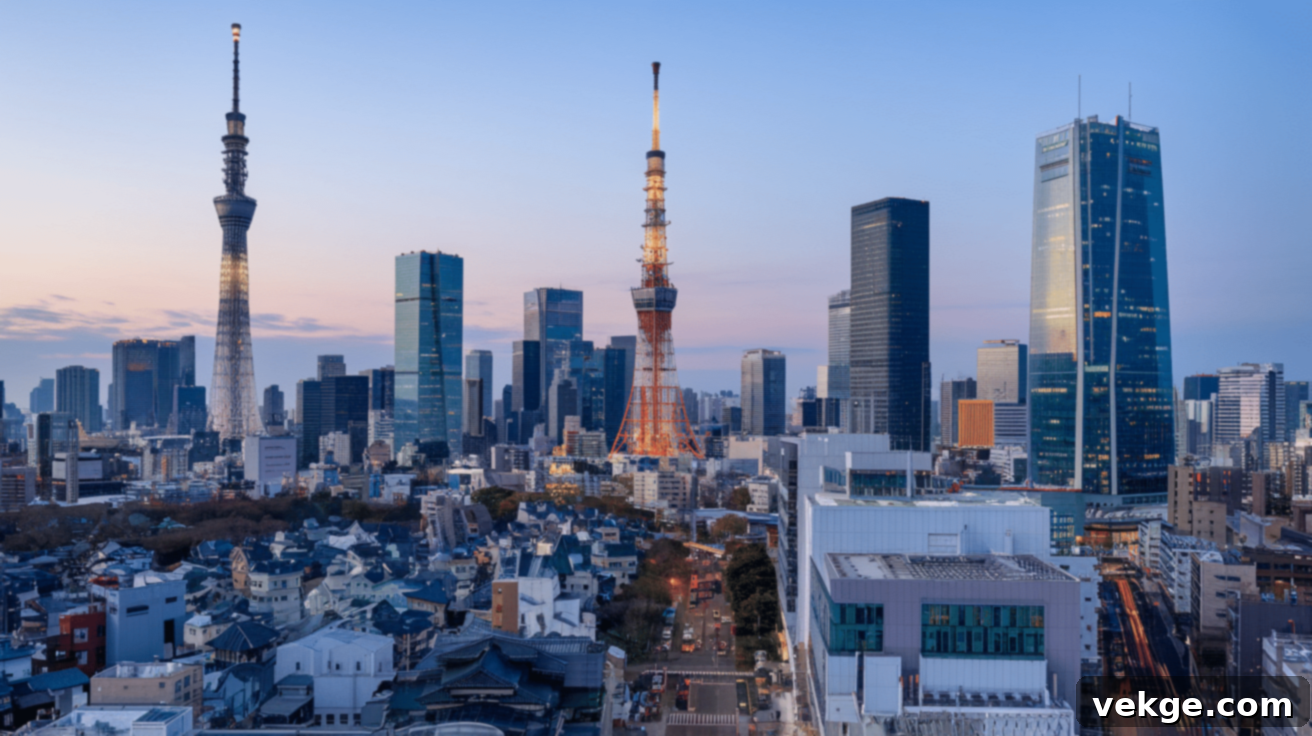Exploring Japan’s Architectural Wonders: A Journey Through Tradition, Innovation, and Sustainable Design
Japan’s architectural landscape is a fascinating tapestry woven from threads of deep tradition and bold innovation. Here, ancient wooden temples stand in serene harmony beside gleaming, ultra-modern skyscrapers, creating a visual dialogue that is uniquely Japanese. This remarkable blend showcases a nation deeply rooted in its cultural heritage yet constantly pushing the boundaries of design and engineering.
The profound influence of nature is a cornerstone of Japanese design philosophy. From meticulously crafted gardens that serve as extensions of indoor spaces to the deliberate use of natural materials like wood and stone, Japanese buildings often seek to invite the outside in. This connection fosters a sense of tranquility and balance, reflecting a core principle of living harmoniously with the environment.
Simplicity and practicality are also hallmarks of Japanese architecture. Designs are often characterized by clean lines, uncluttered spaces, and a minimalist aesthetic that finds beauty in understated elegance. This approach, rooted in philosophies like wabi-sabi, emphasizes functionality and the inherent beauty of natural forms and textures, creating spaces that are both serene and efficient.
From the delicate craftsmanship of traditional tea houses to the sleek, towering structures that define Tokyo’s skyline, every building tells a story. They embody Japan’s rich culture, its reverence for nature, and its relentless pursuit of innovation. Join us as we explore some of Japan’s most famous and interesting buildings, revealing the layers of history, artistry, and advanced engineering that make them truly extraordinary.
Famous Modern Buildings in Japan
Japan’s metropolises are vibrant showcases of contemporary architectural brilliance. These modern marvels not only serve functional purposes but also stand as symbols of Japan’s technological prowess, innovative spirit, and ambitious urban development. Each structure pushes design boundaries, contributing to the country’s iconic skylines and offering unique experiences.
1. Tokyo Skytree
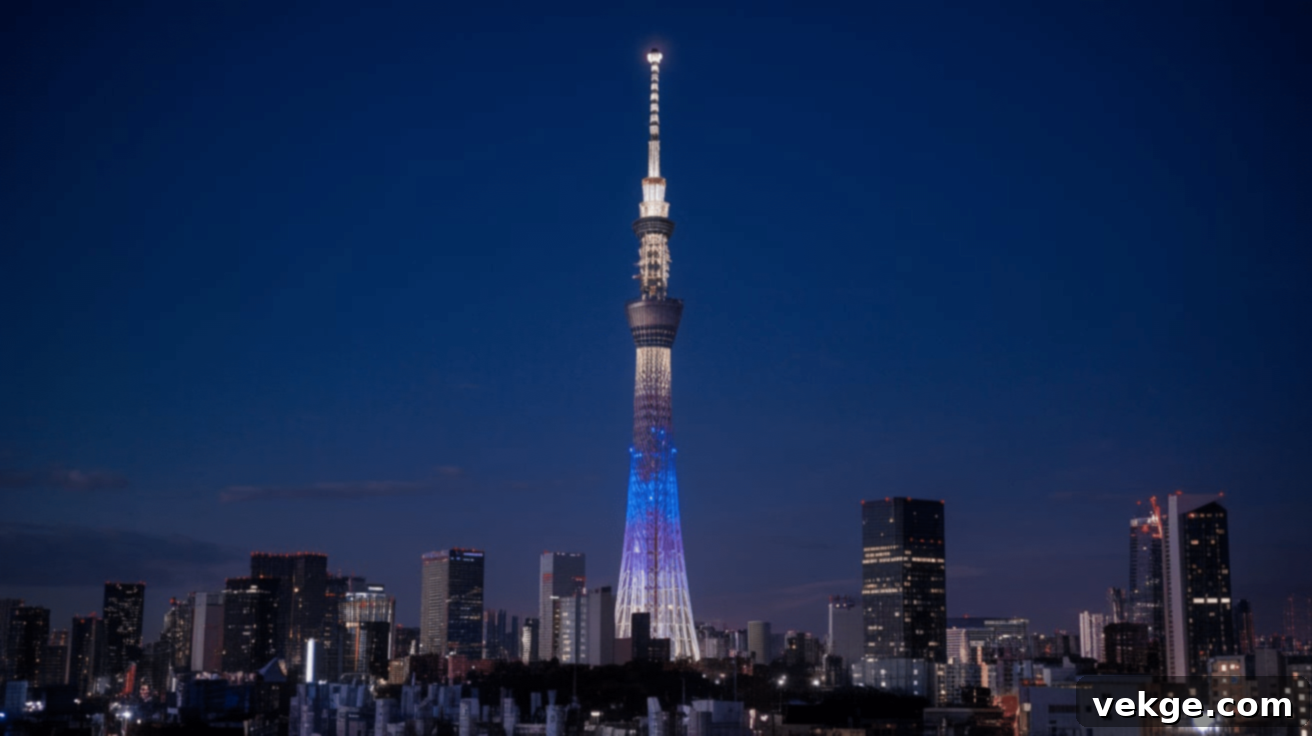
Completed in 2012, the Tokyo Skytree dominates the city’s skyline as Japan’s tallest structure, soaring to an impressive height of 634 meters. Designed as a broadcasting, restaurant, and observation tower, its elegant, futuristic form makes it an unmissable landmark. Its unique design, which subtly references traditional Japanese aesthetics while employing cutting-edge engineering, ensures its stability against earthquakes, a critical consideration in Japan.
The Tokyo Skytree is visible from virtually every corner of Tokyo, serving as a modern beacon and a testament to Japan’s architectural ambition. Its observation decks offer breathtaking panoramic views, making it one of the city’s most popular tourist destinations and a vital part of its contemporary identity.
2. Tokyo Tower
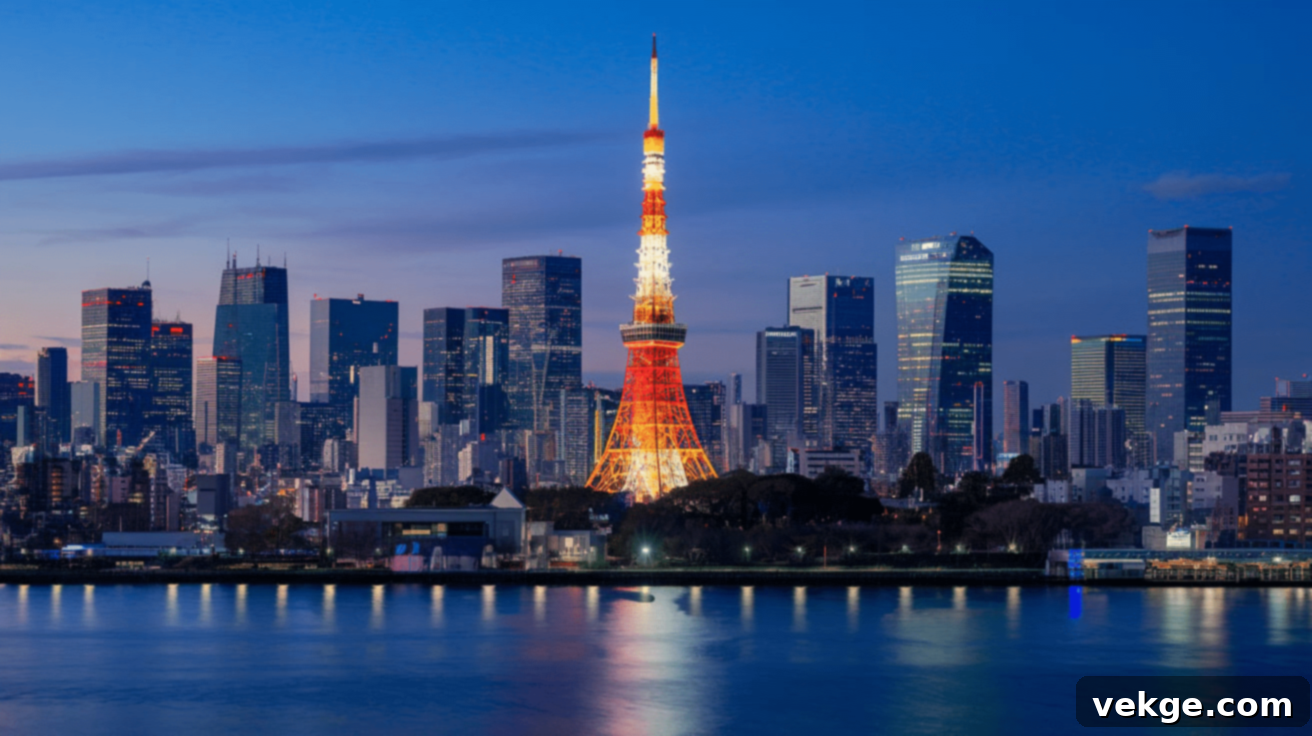
Inspired by the iconic Eiffel Tower, Tokyo Tower was completed in 1958. Standing at 333 meters, it held the title of Japan’s tallest structure for over five decades until the completion of the Tokyo Skytree. More than just a broadcasting tower, it became an enduring symbol of Japan’s rapid post-war recovery and its remarkable technological advancement.
This classic landmark, with its distinctive red and white lattice structure, continues to be a beloved feature of the Tokyo landscape. Its observation decks provide visitors with expansive views of the sprawling metropolis, evoking a sense of nostalgia while still playing an active role in the city’s infrastructure and tourism.
3. Yokohama Landmark Tower
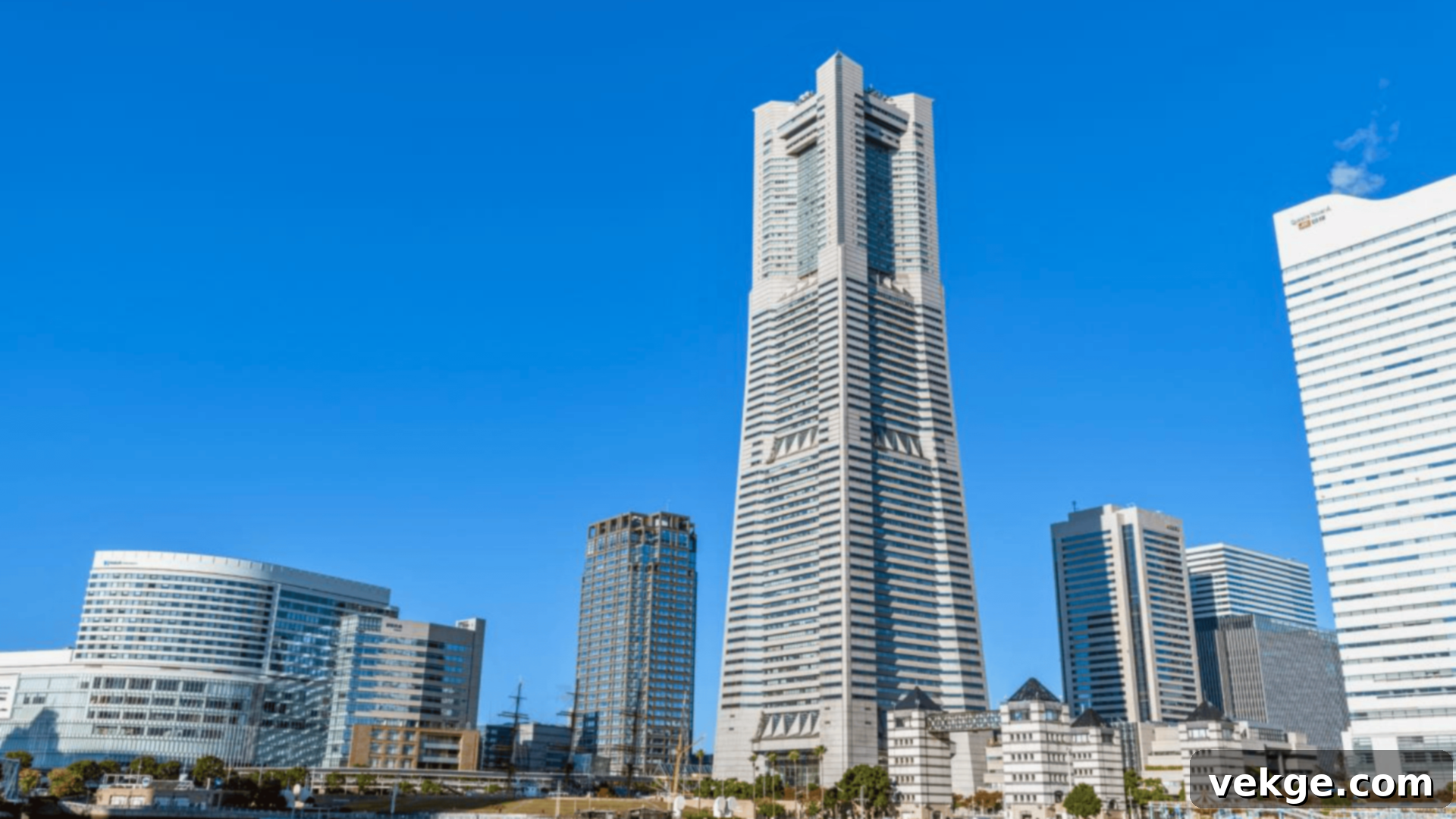
Opened in 1993, the Yokohama Landmark Tower is one of Japan’s tallest buildings, reaching 296 meters. This multi-purpose skyscraper seamlessly integrates office spaces, a luxury hotel, and extensive commercial areas, creating a dynamic urban hub within a single, striking structure. Its presence significantly reshaped the Yokohama skyline and contributed to the city’s modernization.
The highlight for many visitors is the Sky Garden observatory on the 69th floor, which provides unparalleled, breathtaking vistas of Yokohama Bay, the cityscape, and on exceptionally clear days, even the majestic Mount Fuji. It epitomizes modern urban living and offers a comprehensive experience from business to leisure.
4. Umeda Sky Building
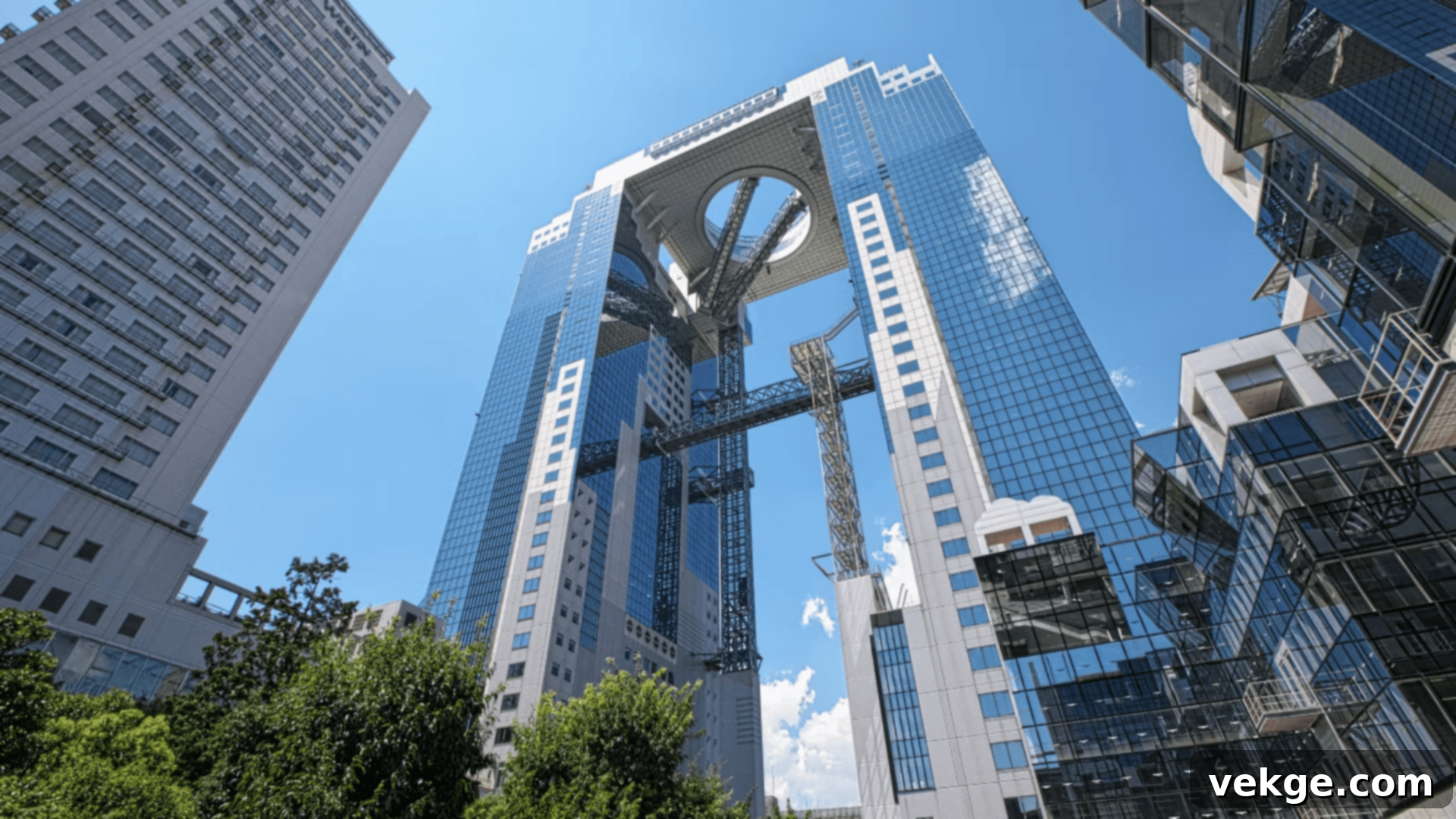
The Umeda Sky Building, completed in 1993, is celebrated for its innovative and futuristic design, particularly its “Floating Garden Observatory.” This unique observation deck connects two 173-meter-tall towers at their uppermost floors, creating an open-air experience unlike any other. Its bold, geometric form makes it an architectural wonder and a prominent feature of the Osaka skyline.
The observatory not only offers stunning panoramic views of Osaka but also provides an exhilarating sense of being suspended high above the city. It has firmly established itself as one of Osaka’s must-see landmarks, attracting visitors eager to experience its distinctive blend of engineering and design.
5. Tokyo International Forum
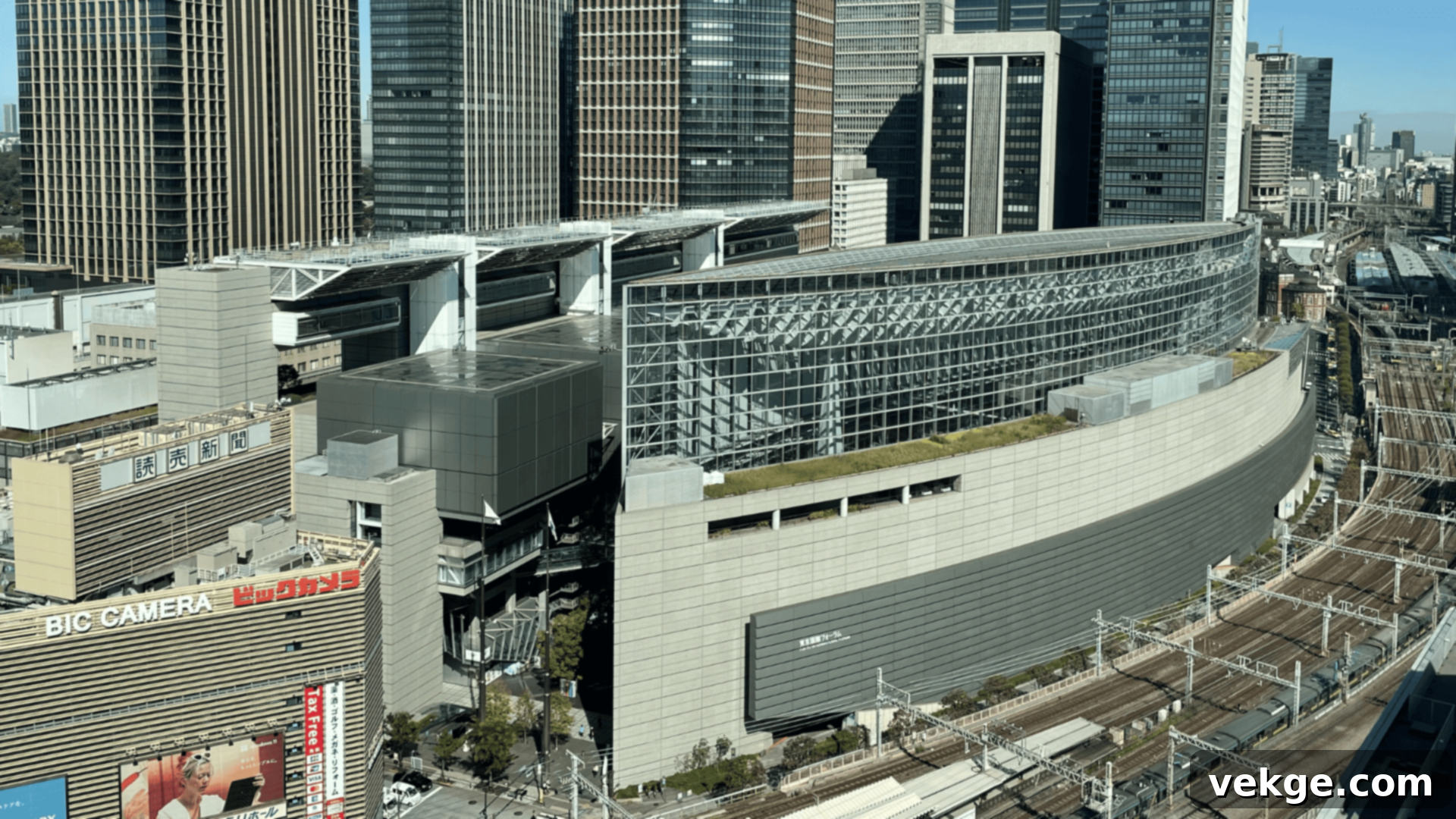
Finished in 1997, the Tokyo International Forum is a masterpiece of contemporary architecture, characterized by its expansive glass-and-steel construction. Primarily a venue for exhibitions and conferences, its most striking feature is an enormous, boat-shaped glass atrium that stretches over 100 meters in length, creating a vast, light-filled public space.
The building is renowned for its innovative design and the seamless integration of art and architecture, making it a powerful symbol of Tokyo’s modernity and its commitment to bold design. Its transparency and grand scale allow natural light to flood the interior, embodying a connection to the external environment while facilitating large public gatherings.
6. Roppongi Hills Mori Tower

Opened in 2003 as the centerpiece of the Roppongi Hills complex, the Mori Tower stands at 238 meters and symbolizes urban transformation in Tokyo. This integrated vertical city houses offices, high-end shops, diverse restaurants, a museum, and residential spaces, creating a vibrant, self-contained community. Its sophisticated design and multifaceted utility reflect a modern approach to urban planning.
The tower is also recognized for its sustainable design principles and offers spectacular views of the city, including iconic landmarks like the Tokyo Tower. It represents a new era of mixed-use development, blending work, leisure, and living in a single, elegantly designed structure.
7. Odaiba Palette Town
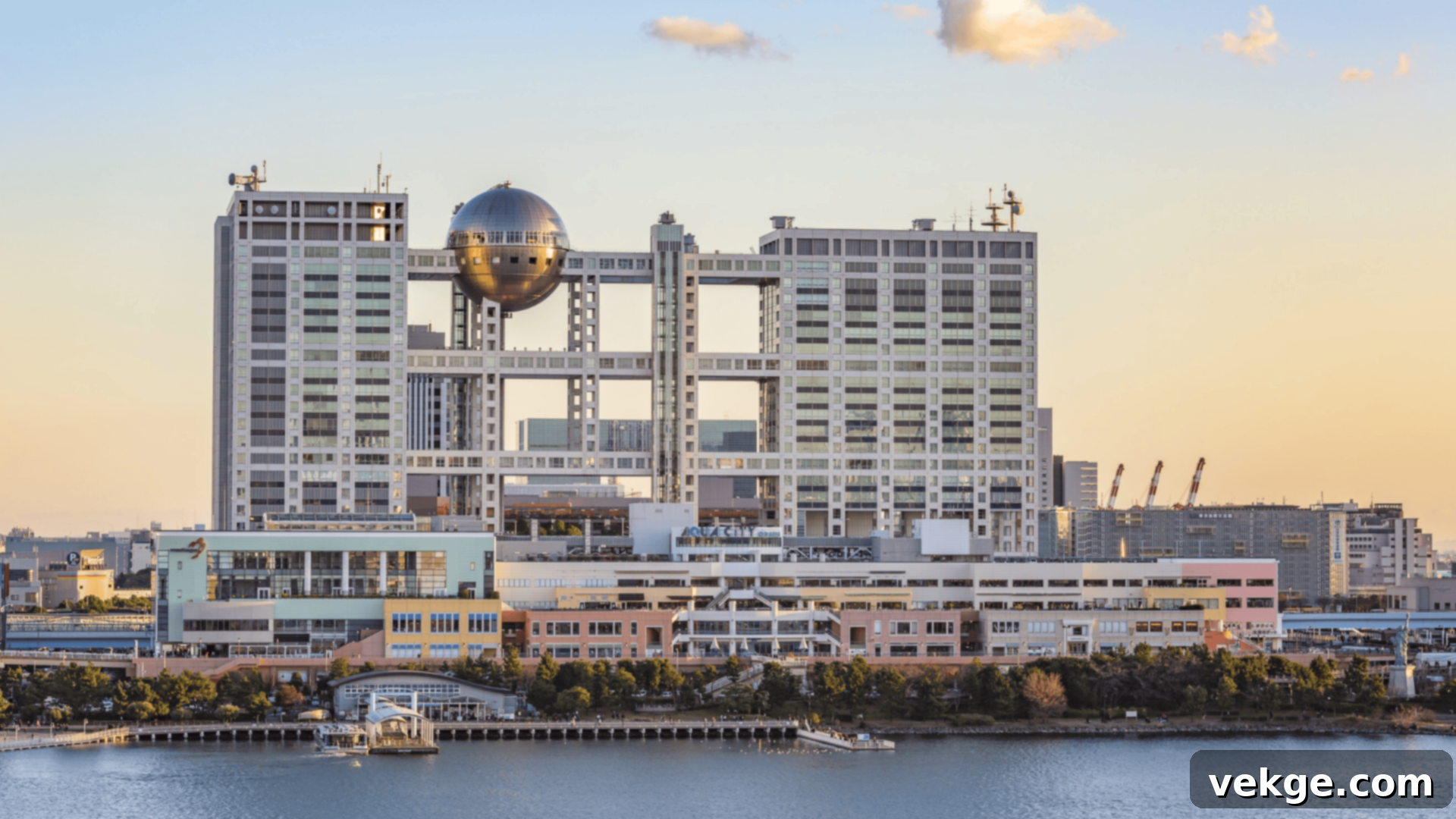
Completed in 1999, Palette Town is a sprawling shopping and entertainment complex located on the artificial island of Odaiba. It features an imaginative, futuristic architectural style, with structures that captivate visitors. Home to a giant Ferris wheel that brilliantly lights up the night skyline, it creates a fantastical, almost theme-park-like atmosphere in the bay area.
Designed with a playful and modern aesthetic, the complex includes various attractions such as a Toyota showroom, numerous entertainment centers, and shopping arcades. It remains a hugely popular spot for both locals and tourists seeking leisure, entertainment, and a glimpse into Japan’s innovative urban planning and leisure culture.
8. The National Art Center, Tokyo
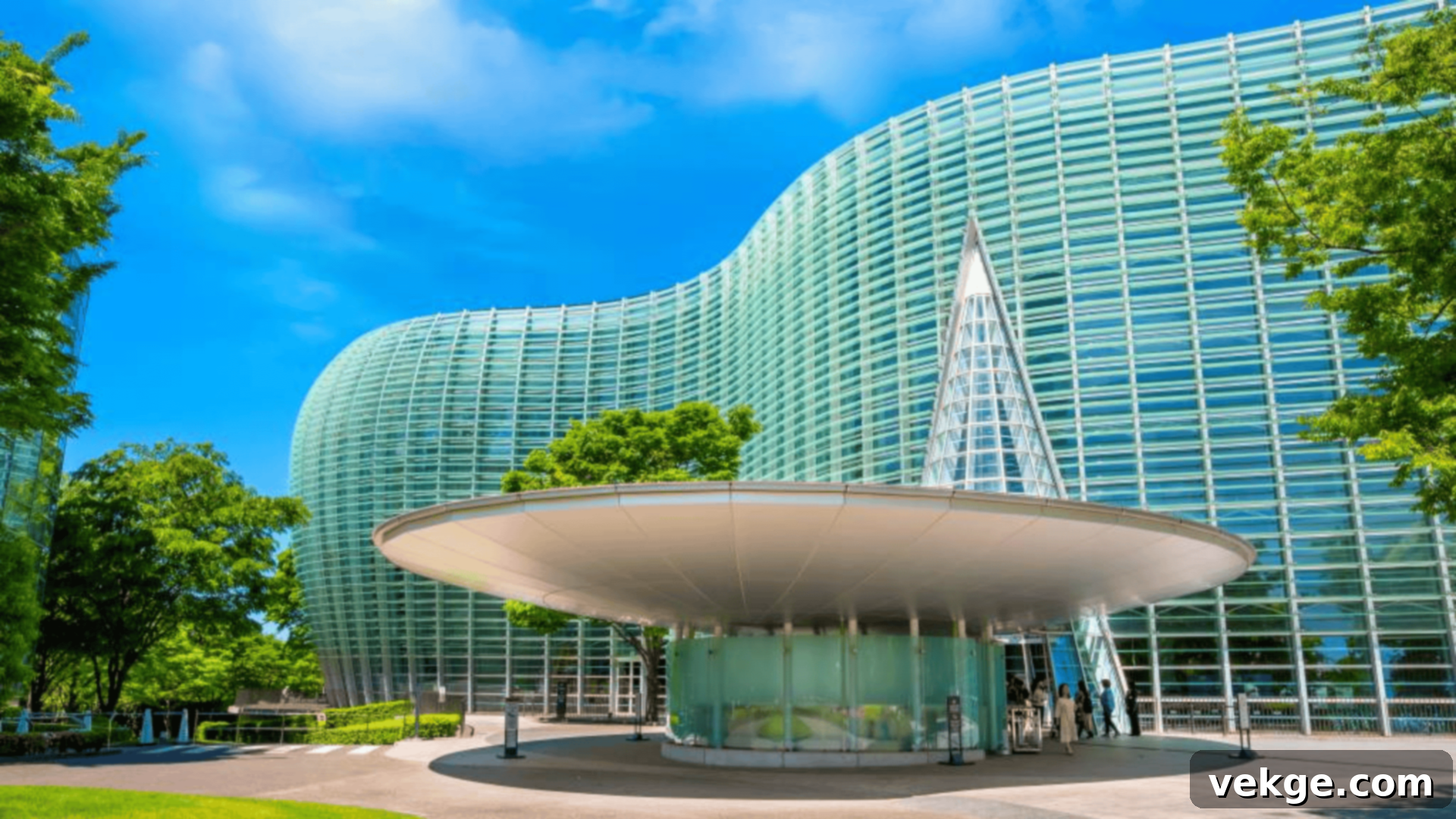
Opened in 2007, The National Art Center in Tokyo is not just a museum but a work of art in itself. It is unique in that it hosts no permanent collections, focusing instead on diverse temporary exhibitions. The building is renowned for its stunning, undulating glass walls, which create a sense of fluid movement, openness, and an abundance of natural light throughout its interior.
Its architectural design, crafted by Kisho Kurokawa, is widely considered one of the finest examples of contemporary Japanese architecture, seamlessly blending the natural environment with modern structure. The transparent facade blurs the lines between indoor and outdoor, embodying a key principle of Japanese design: connection to nature.
9. The Asahi Beer Tower
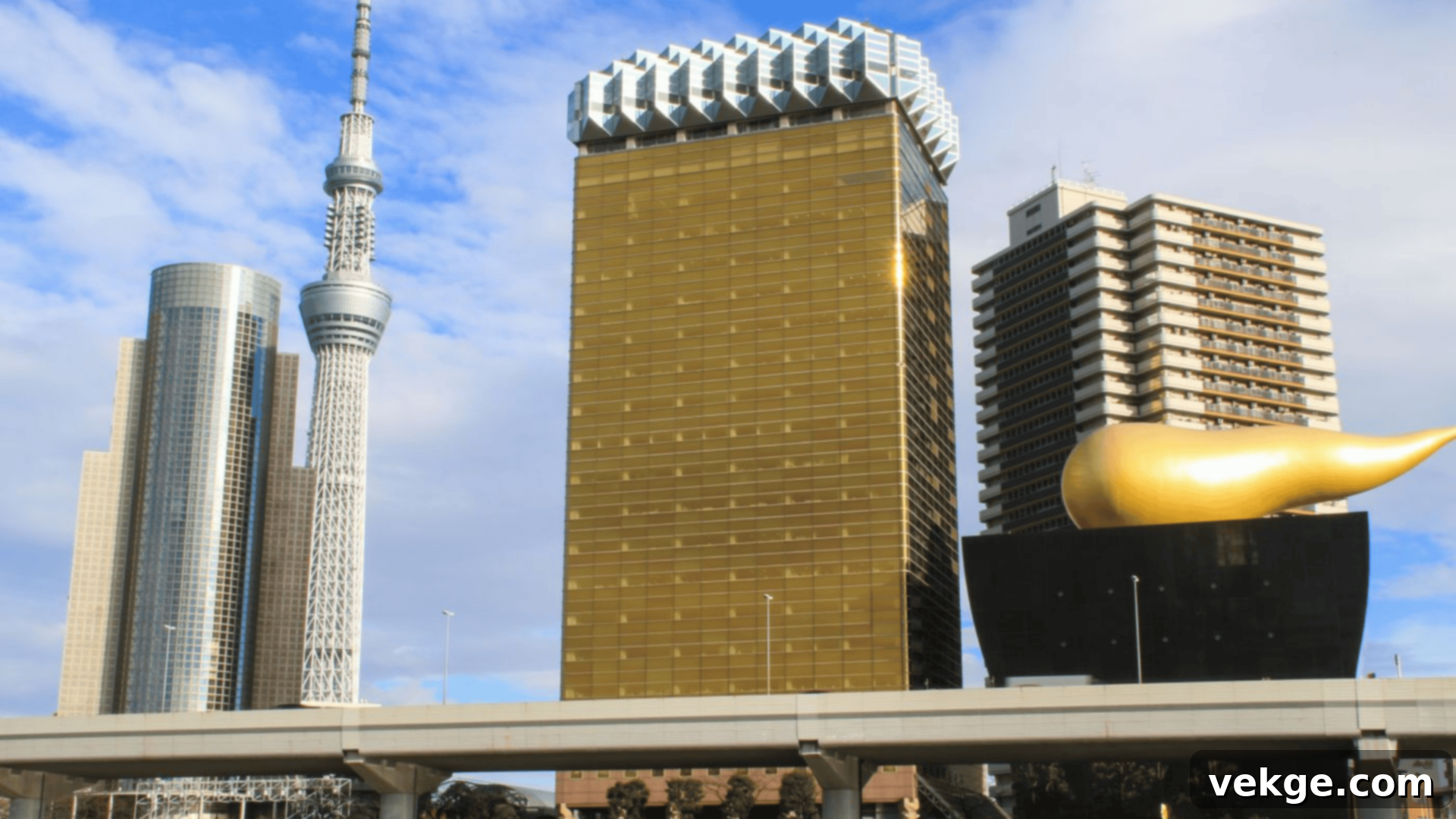
The Asahi Beer Tower, completed in 1989, is famous for its bold, unconventional, and instantly recognizable design. The building is distinctively topped with a massive, gold-colored flame-like sculpture, often referred to as the “Asahi Flame” or “Golden Turd,” which is said to represent the “burning spirit” of the beer company. This striking form immediately draws the eye and sparks conversation.
Housing corporate offices and the Asahi Beer Hall, its audacious and memorable design has made it an iconic and somewhat whimsical part of Tokyo’s diverse and ever-evolving skyline. It stands as a testament to corporate branding meeting architectural expression in an unforgettable way.
Traditional and Historic Japanese Architecture
Beyond the gleaming skyscrapers, Japan’s architectural heritage runs deep, rooted in centuries of tradition, spirituality, and masterful craftsmanship. These historic structures, ranging from ancient temples and shrines to powerful castles, offer a tangible link to Japan’s past, showcasing the enduring beauty and ingenuity of traditional Japanese building techniques and philosophies.
10. Kinkaku-ji (Golden Pavilion)
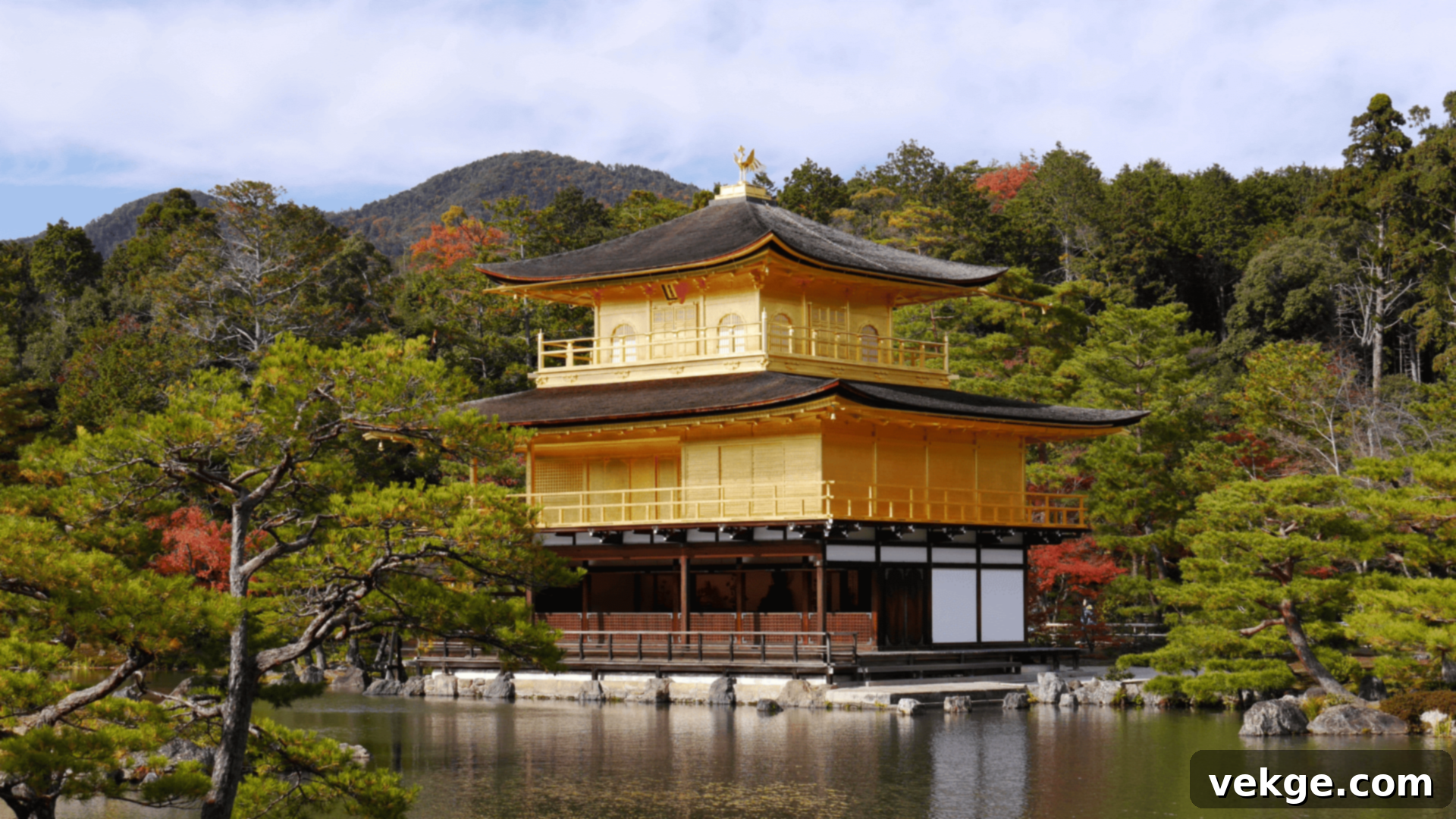
Kinkaku-ji, universally known as the Golden Pavilion, is a magnificent Zen Buddhist temple located in Kyoto, originally completed in 1397. It is world-renowned for its dazzling golden exterior, specifically the upper two floors completely covered in gold leaf, which reflects with breathtaking beauty in the serene surrounding pond, Kyo-ko (Mirror Pond).
As one of Japan’s most iconic landmarks, Kinkaku-ji perfectly symbolizes traditional Japanese beauty, tranquility, and the aesthetic principles of Zen. The temple’s architecture, harmoniously integrated with its meticulously landscaped garden, creates a peaceful and deeply meditative atmosphere, inviting contemplation and awe from visitors worldwide.
11. Meiji Shrine
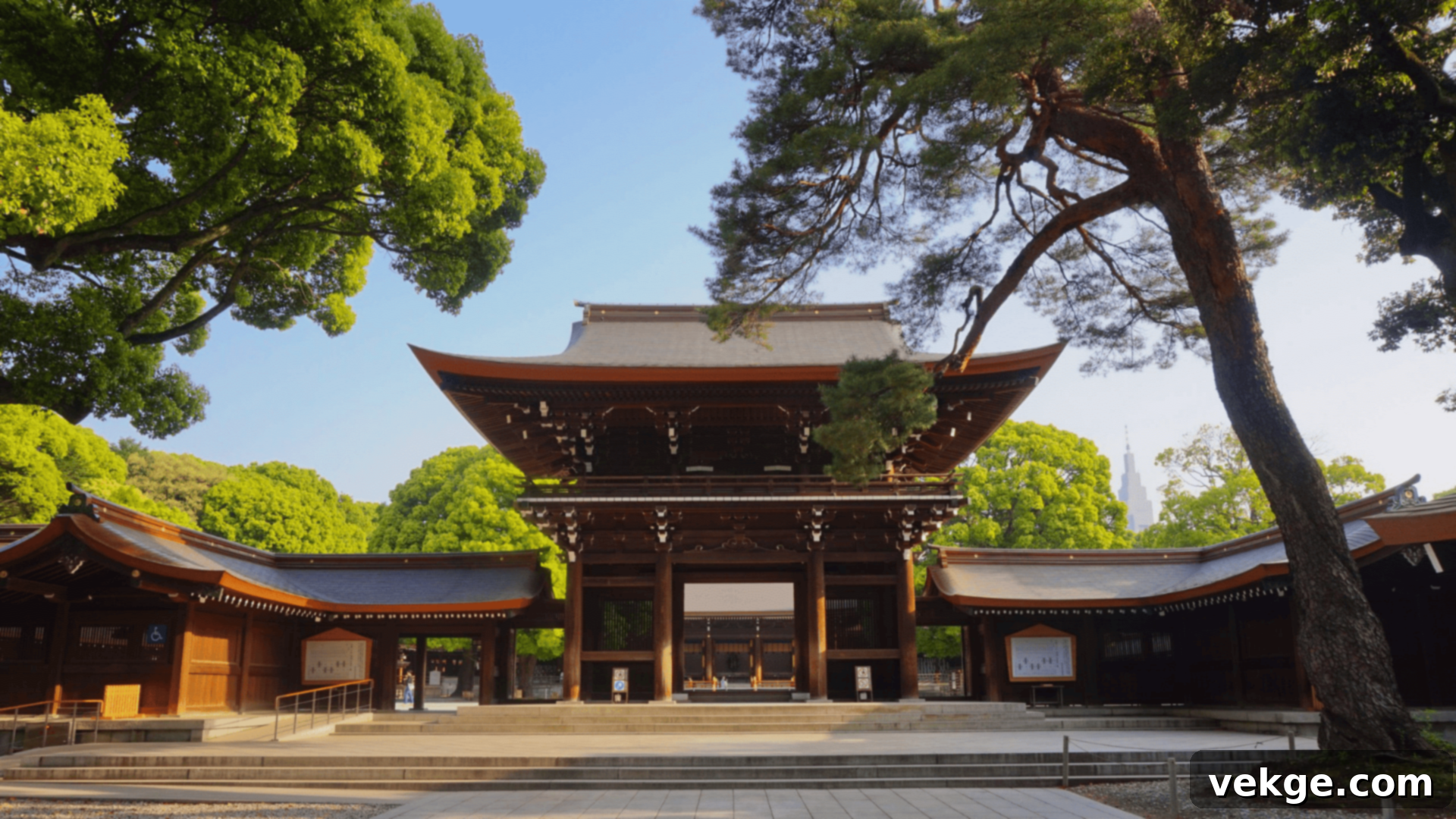
Nestled in the heart of Tokyo, the Meiji Shrine is a solemn and majestic Shinto shrine dedicated to Emperor Meiji and Empress Shoken. Completed in 1920, the shrine is enveloped by an expansive, lush forest comprising over 100,000 trees donated from all over Japan, offering a remarkably tranquil escape from the bustling urban environment that surrounds it.
The shrine’s structures are built using traditional wooden techniques, emphasizing simplicity, natural materials, and elegant, unadorned forms. Its design is a prime example of the authentic Shinto architectural style, characterized by clean lines, impressive torii gates, and a deep reverence for the natural setting, inviting visitors to experience peace and spiritual reflection.
12. Senso-ji Temple
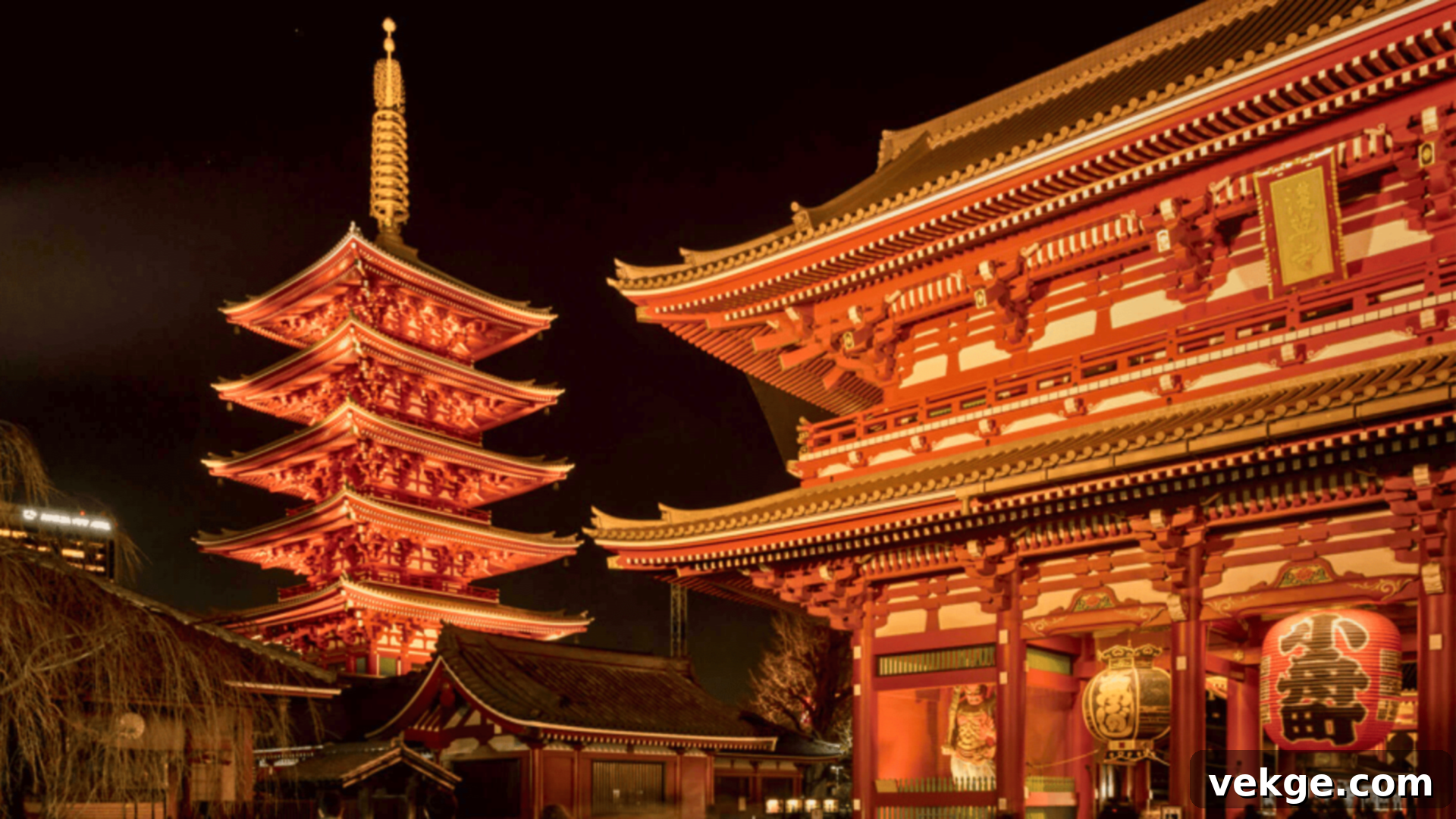
Senso-ji Temple, located in Tokyo’s historic Asakusa district, is one of Japan’s oldest and most revered Buddhist temples, with its origins tracing back to the 7th century. It is instantly recognizable by its iconic large red pagoda, the impressive Kaminarimon (Thunder Gate) with its giant lantern, and the bustling Nakamise-dori market street leading up to it.
The temple’s architecture incorporates quintessential traditional Japanese elements, predominantly utilizing wood and paper screens, which create a warm, inviting, and profoundly spiritual atmosphere. Despite numerous reconstructions over the centuries, Senso-ji maintains its historical aesthetic, drawing millions of visitors annually who come to admire its beauty, partake in its rituals, and explore its vibrant surroundings.
Castles in Japan
Japanese castles stand as powerful symbols of feudal Japan’s military might, political power, and sophisticated craftsmanship. These magnificent structures, often perched atop strategic hills or surrounded by intricate moats, seamlessly blend defensive practicality with aesthetic grandeur. Each castle tells a story of samurai, shoguns, and significant historical events, reflecting the architectural ingenuity of their respective eras.
Himeji Castle, a UNESCO World Heritage site, is perhaps the finest and best-preserved example, dating back to the 17th century. Other notable examples like Osaka Castle and Nagoya Castle, though partly reconstructed, also feature imposing stone walls, elegant multi-tiered wooden structures, and interiors designed for both robust defense and the comfort of their lord.
13. Himeji Castle
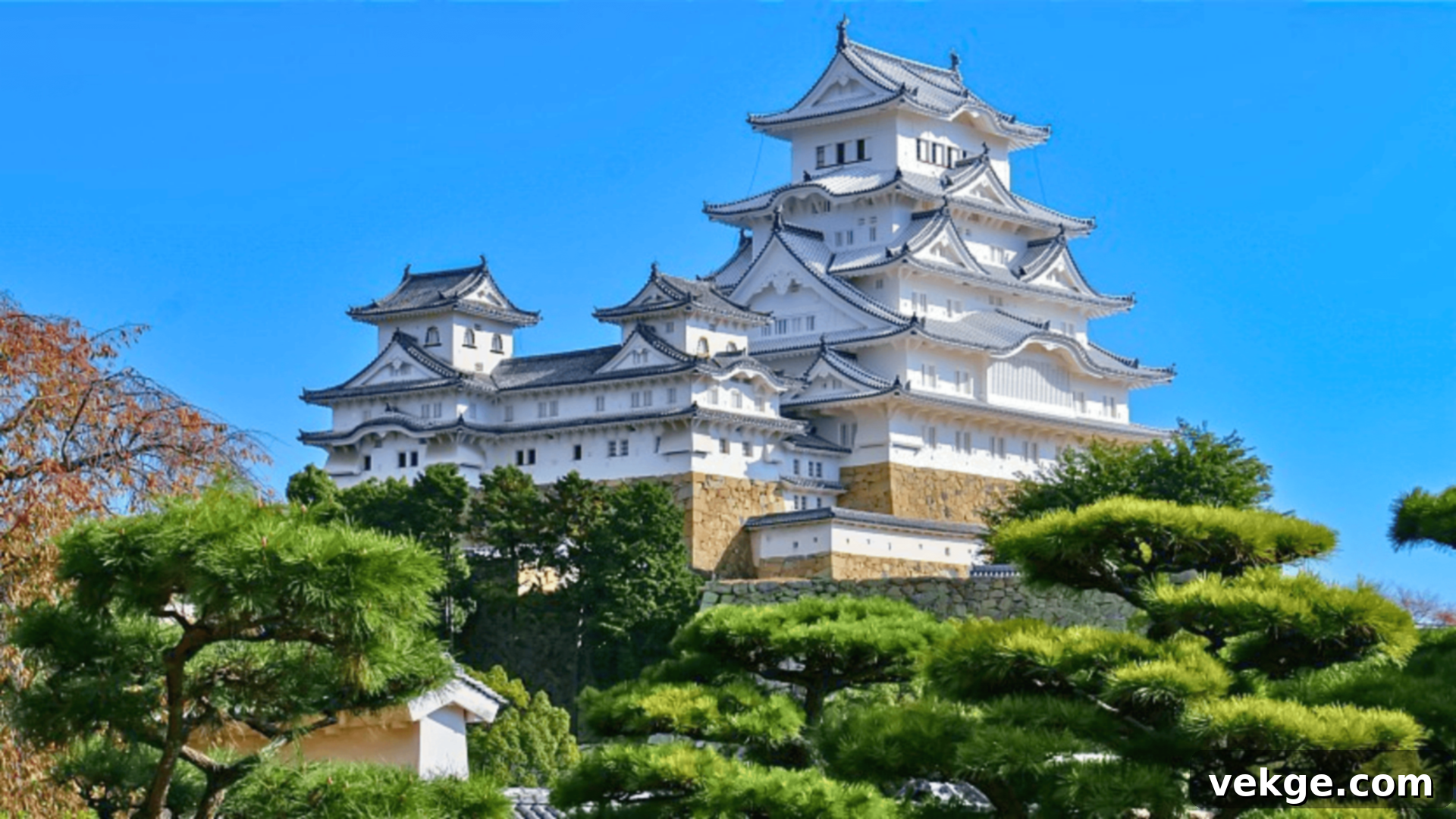
Himeji Castle, affectionately known as the “White Heron Castle” due to its graceful, white-plastered walls and soaring roofs that resemble a bird in flight, is celebrated worldwide for its unparalleled beauty and formidable defensive structures. Originally built in the 14th century and extensively expanded in the 17th century, it is one of Japan’s most famous, most magnificent, and remarkably well-preserved original castles.
The castle’s complex labyrinthine pathways, hidden doors, and defensive walls are ingeniously blended with an aesthetic elegance that makes it a true masterpiece. Himeji Castle is a living symbol of feudal Japan, showcasing an extraordinary integration of military architecture and artistic design, and offering a profound glimpse into Japan’s rich history.
14. Osaka Castle
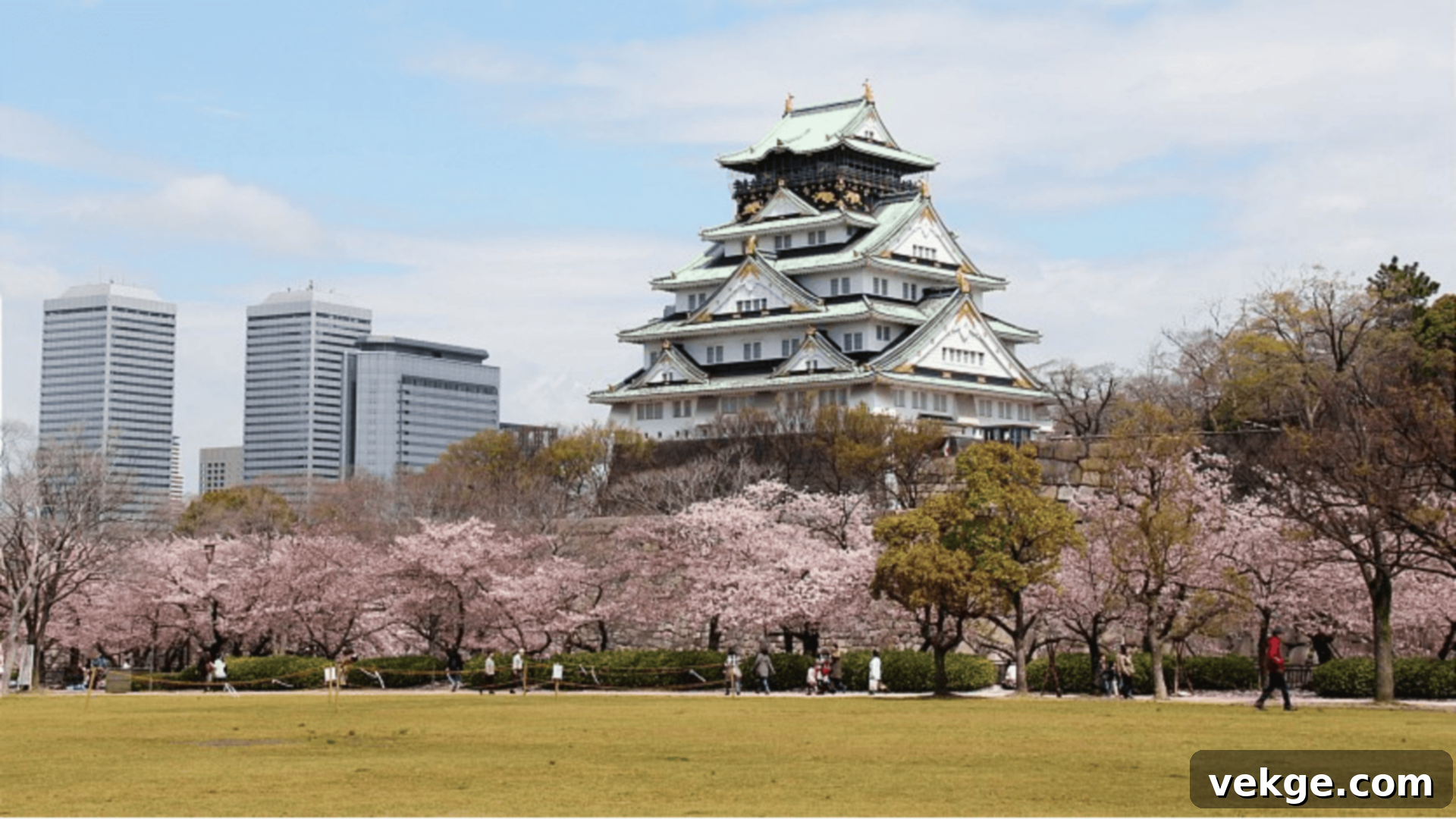
Constructed in the late 16th century by Toyotomi Hideyoshi, Osaka Castle was once the largest and most powerful castle in Japan, symbolizing the immense power and ambition of the Toyotomi clan. Though it has undergone several destructions and reconstructions, its imposing presence continues to dominate the Osaka landscape, serving as a powerful historical monument and a beloved tourist destination.
The castle is particularly renowned for its massive stone walls, the vast moats that encircle it, and its iconic main tower, which features a distinctive golden roof and intricate decorations. Inside, the modern reconstruction houses a museum detailing its rich history, allowing visitors to delve into the saga of this legendary fortress.
15. Nagoya Castle
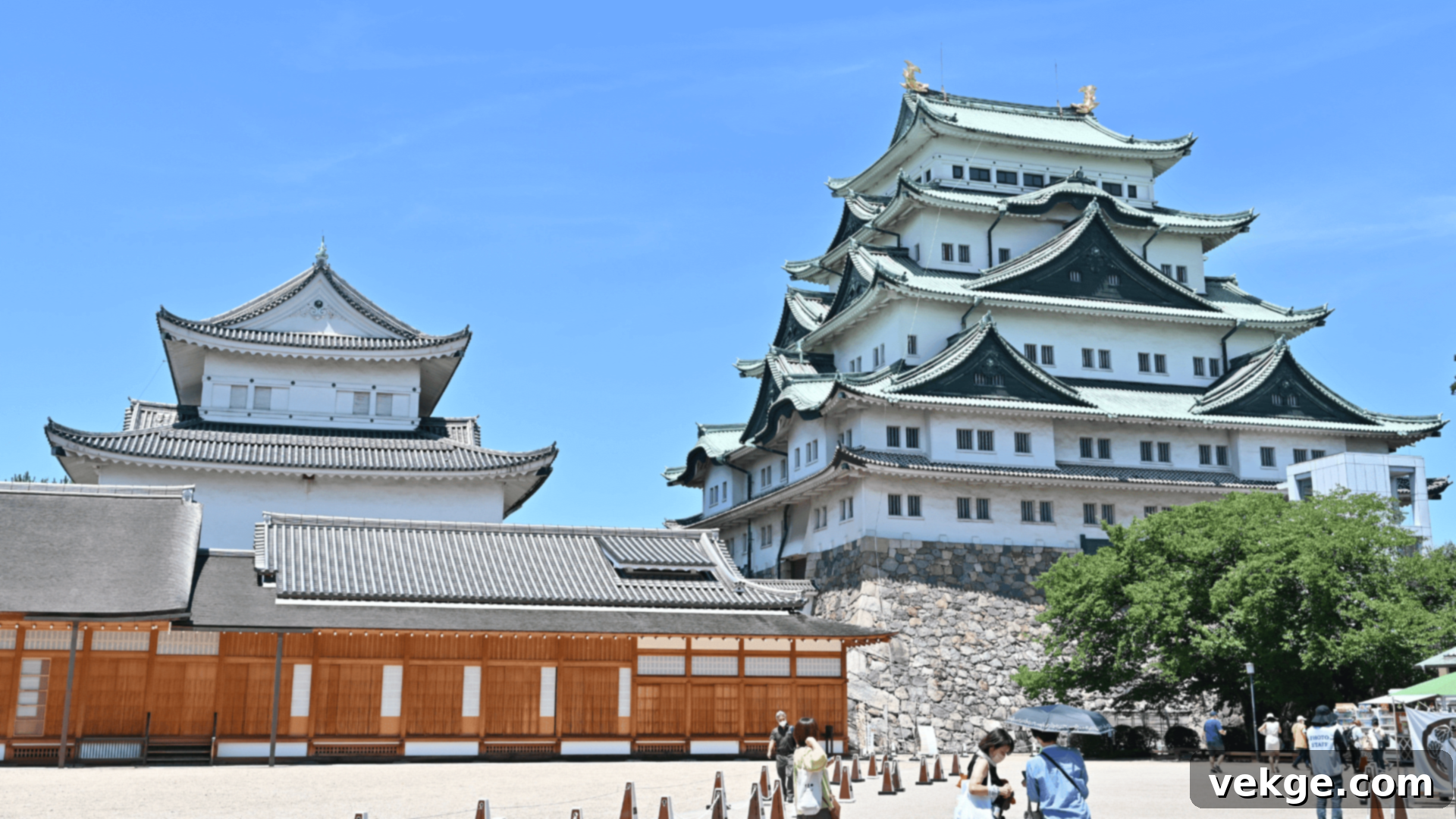
Nagoya Castle, originally constructed in the early 17th century by Tokugawa Ieyasu, is famous for its magnificent golden shachihoko (a mythical creature with a tiger’s head and a carp’s body) adorning the roofs of its main keep. These gleaming figures are symbols of prosperity and protection, adding a unique grandeur to the castle’s silhouette.
The castle played a pivotal role in the history of the Tokugawa shogunate, serving as a crucial stronghold and a residence for one of the three Tokugawa branches. It masterfully combines traditional castle design with elements reflecting samurai culture and the immense power of its occupants, offering a compelling insight into a crucial period of Japanese history and architecture.
Tea Houses in Japan
Traditional Japanese tea houses, known as chashitsu, are far more than mere buildings; they are meticulously designed sanctuaries for quiet contemplation, aesthetic appreciation, and the practice of the intricate tea ceremony (chanoyu). These small, often secluded spaces are typically built with the utmost simplicity using natural materials like wood, bamboo, and straw, and are designed to blend seamlessly into their surrounding gardens.
The design of a tea house embodies the Japanese philosophy of wabi-sabi, which celebrates the beauty of imperfection, impermanence, and understated elegance. Every element, from the entrance (nijiriguchi) that requires guests to humble themselves, to the subtle interplay of light and shadow, is carefully considered to create a serene and reflective environment, fostering a deep connection between host and guest.
16. Koshinji Tea House

The Koshinji Tea House in Kyoto is an exemplary representation of classic Japanese tea house design and its inherently serene atmosphere. It beautifully embodies the wabi-sabi philosophy, embracing simplicity, natural imperfection, and the transient beauty of nature within its very structure and setting. The architecture is deliberately modest, drawing attention to the ritual and the natural elements.
This traditional tea house is frequently used for authentic tea ceremonies, offering a quiet, intimate space for contemplation and reflection. The careful arrangement of its interior, the choice of materials, and its harmonious integration with the surrounding garden all contribute to an experience designed to foster inner peace and a profound appreciation for the present moment.
Wooden Structures in Japanese Architecture
Wood has been the quintessential building material in Japanese architecture for millennia, deeply ingrained in the nation’s cultural and spiritual identity. The extensive use of wood in traditional buildings such as temples, shrines, residential homes, and even castles, profoundly reflects Japan’s intrinsic connection to nature and its mastery of carpentry techniques passed down through generations.
Japanese wooden structures are celebrated not only for their inherent flexibility, which provides remarkable resilience against earthquakes, but also for their natural beauty. The distinctive grain patterns, textures, and warmth of wood often add unique character and a sense of organic charm to the design. Many historical masterpieces, including sections of Kinkaku-ji and the original structures of Himeji Castle, have miraculously maintained their wood-based construction for centuries, a testament to the durability of the material and the skill of their builders, contributing significantly to their timeless appeal and cultural significance.
17. Ise Shrine
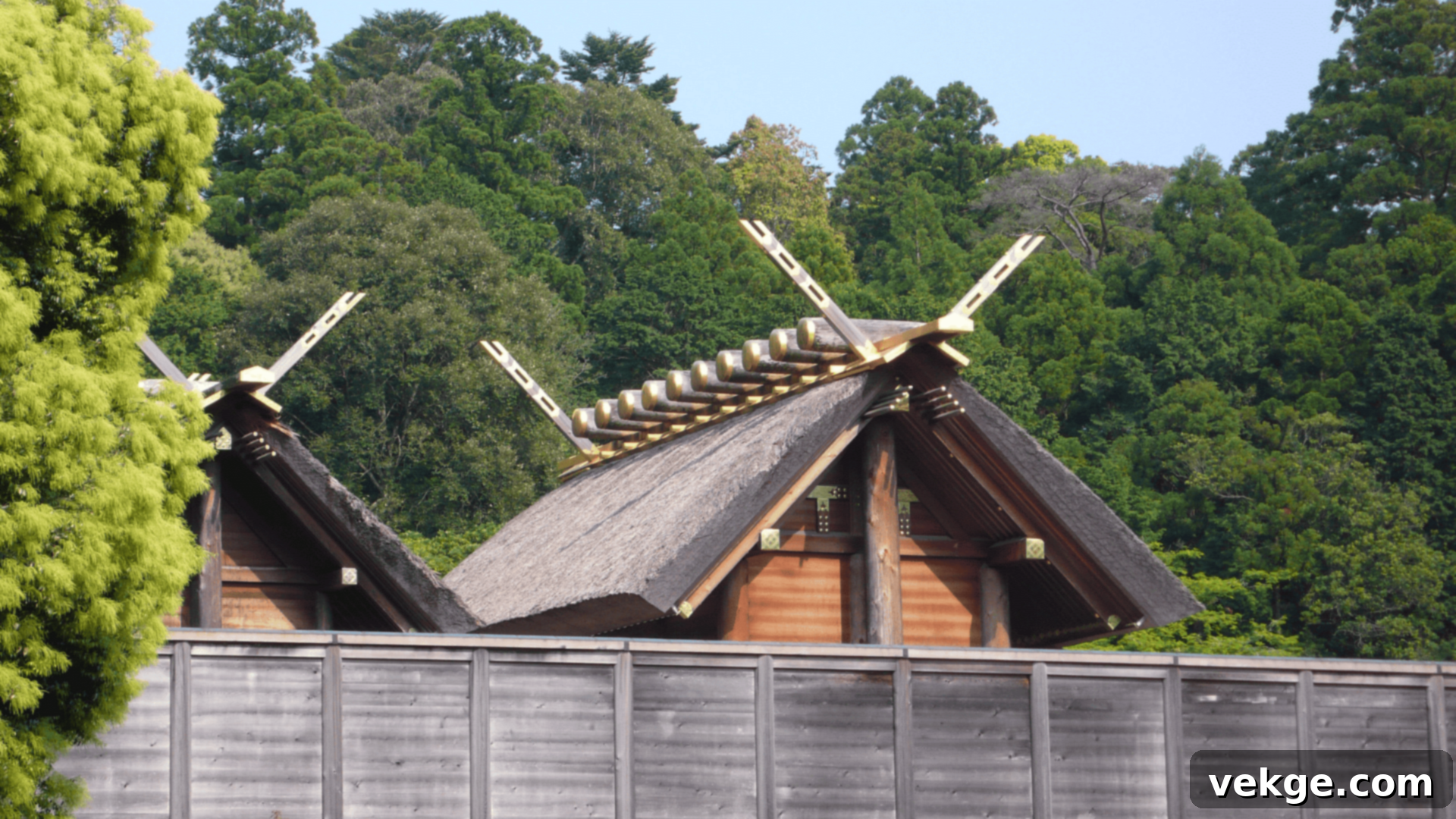
Ise Grand Shrine (Ise Jingu), one of Japan’s most sacred Shinto sites, stands as a unique and profound example of devotion to tradition and the art of wooden architecture. In an extraordinary practice known as Shikinen Sengu, the main shrine buildings are completely rebuilt from scratch every 20 years on an adjacent site, using new timber. This ensures that its wooden structures are perpetually maintained in pristine condition and that ancient building techniques are preserved and passed down through generations.
The shrine is a perfect embodiment of Japan’s dedication to nature, harmonizing completely with its surrounding ancient forest environment. The exclusive use of unpainted cypress wood and its distinctive thatched roofs enhance its natural beauty and convey a sense of purity and ancient sanctity, making it a spiritual and architectural marvel.
18. Todai-ji Temple
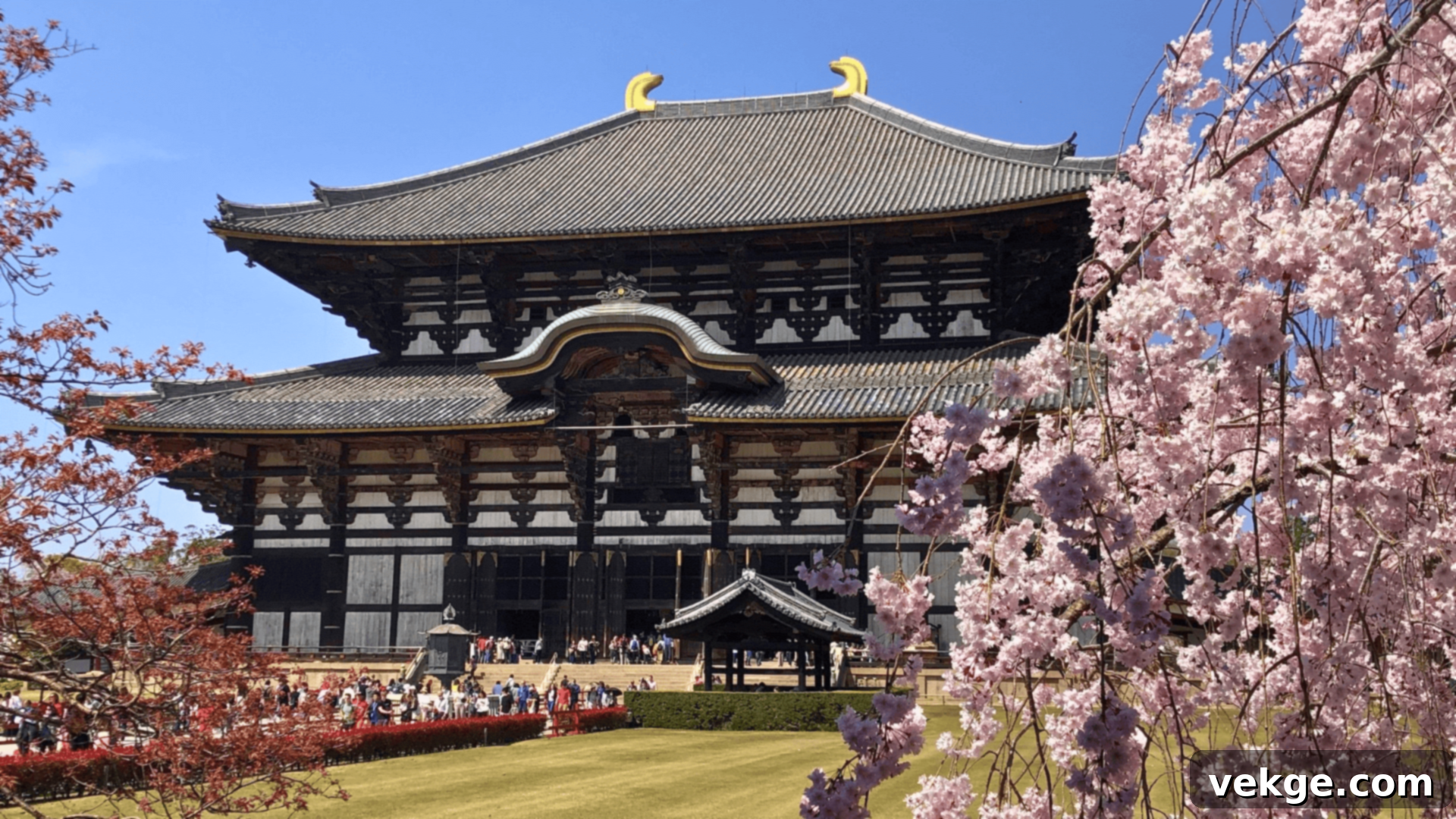
Another iconic example of monumental wooden architecture is the Todai-ji Temple in Nara, famed for housing the Great Buddha (Daibutsu) statue. The immense wooden structure of its main hall, the Daibutsuden (Great Buddha Hall), dates back to the 8th century and, despite being rebuilt twice on a slightly smaller scale, remains one of the largest wooden buildings in the world. Its sheer size and historical significance are awe-inspiring.
The temple’s grandeur and its remarkable preservation over centuries showcase the incredible scale, strength, and flexibility of wood when employed in traditional Japanese architectural masterpieces. It stands as a testament to the engineering capabilities and artistic vision of ancient Japanese builders, continuing to inspire reverence and wonder.
Natural Light and Connection to Nature
A defining characteristic of Japanese architecture, both traditional and modern, is its profound emphasis on integrating the indoors with the outdoors. This design philosophy goes beyond mere aesthetics; it’s about fostering a seamless, harmonious connection to nature and creating spaces that promote peace and well-being. Elements like sliding doors (fusuma and shoji), expansive open spaces, and meticulously designed gardens are strategically incorporated to blur the boundaries between interior and exterior.
This thoughtful integration allows natural light to flood living spaces, creates refreshing cross-ventilation, and provides constant visual access to the changing seasons and the beauty of the natural world. It nurtures a sense of tranquility and an appreciation for the subtle shifts in the environment, embodying a core tenet of Japanese aesthetics: the appreciation of beauty in transience.
Historic masterpieces such as Katsura Imperial Villa and the contemplative Ryoan-ji Zen Garden are prime examples of this seamless blend. In these designs, gardens are not merely decorative elements but integral components that extend the living space and play a crucial role in shaping the entire architectural experience, inviting quiet reflection and a deep connection to the natural world.
19. Katsura Imperial Villa
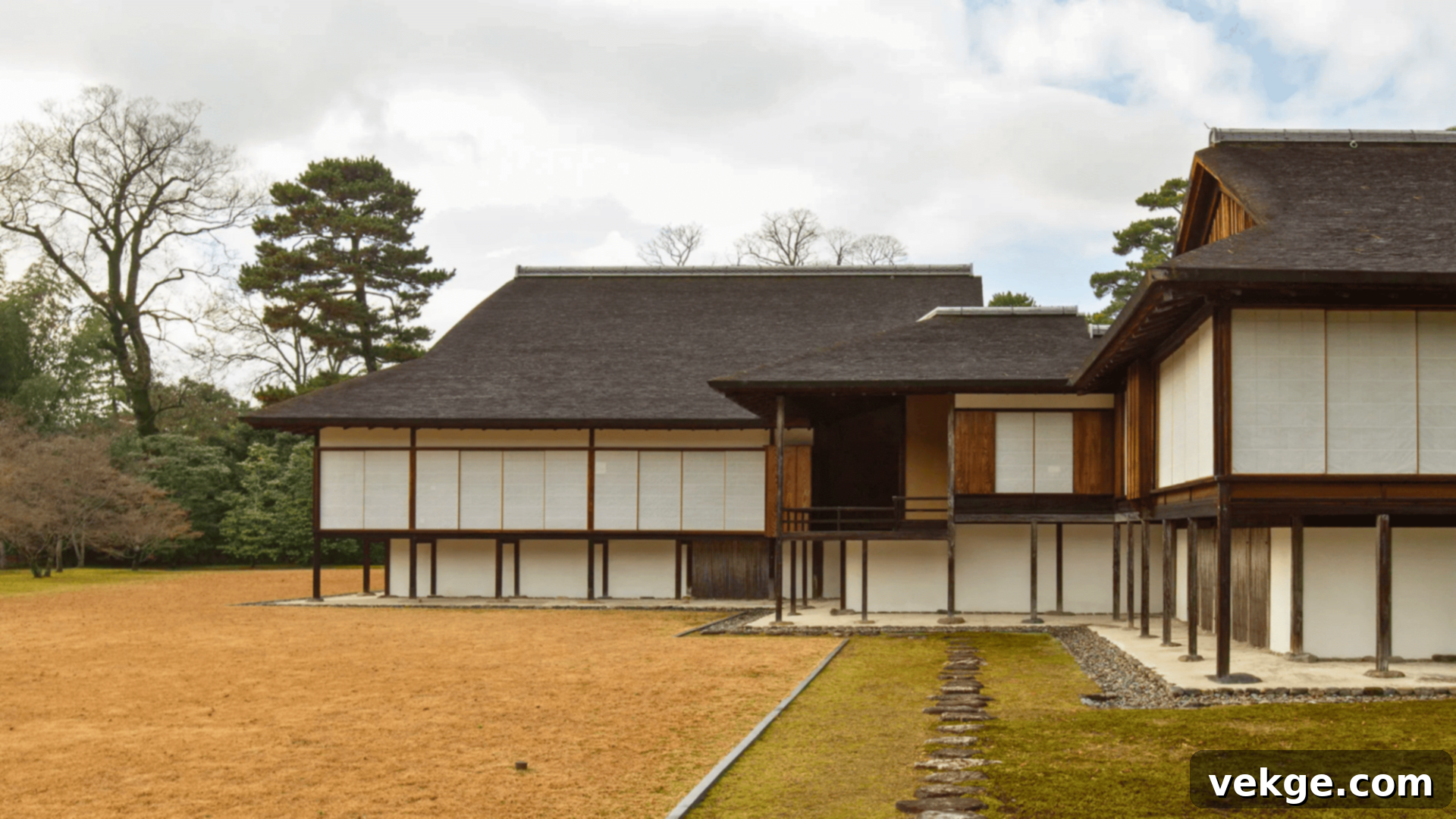
Katsura Imperial Villa in Kyoto is widely considered one of the pinnacles of traditional Japanese architecture and landscape design, showcasing an exquisite mastery of how to integrate buildings with nature. The villa’s design meticulously incorporates carefully placed gardens, elegant wooden structures, and expansive verandas (engawa), all oriented to allow for an uninterrupted, flowing view of the natural surroundings from almost any interior point.
Every element is designed to encourage a harmonious, intimate relationship between the indoors and the outside world, inviting residents and visitors to constantly engage with the landscape. It is a living example of how architecture can enhance, rather than dominate, its natural setting, creating a space of profound beauty and peaceful integration.
20. Ryoan-ji Zen Garden

The Ryoan-ji Zen Garden, specifically its iconic dry landscape (karesansui) garden, is an essential and globally recognized element within Japanese architecture and cultural thought. While not a building in the traditional sense, it is an integral architectural space, embodying the spiritual connection to nature and the principles of Zen Buddhism. This minimalistic garden consists of carefully raked white gravel and fifteen strategically placed rocks, arranged in such a way that no matter where you sit, at least one rock is always hidden from view.
The garden’s design is meant to evoke deep meditation and contemplation, encouraging observers to connect profoundly with the natural world and their inner selves through abstraction and symbolism. It’s a powerful testament to how simplicity, when masterfully executed, can create a space of immense depth and spiritual resonance.
Simplicity and Minimalism
The philosophical aesthetic of wabi-sabi plays a profoundly significant role in shaping Japanese architecture. It champions simplicity, celebrates the beauty found in imperfection and transience, and reveres the authenticity of natural materials. This aesthetic translates into designs characterized by clean lines, uncluttered spaces, and a quiet, calm atmosphere that encourages introspection and peace.
Japanese buildings often eschew excessive ornamentation, focusing instead on subtle details, the texture of materials, and the careful interplay of light and shadow. This deliberate minimalism allows the space itself to “breathe,” fostering a sense of peace and tranquility. Gardens like Kenrokuen and the intimate Tei-en Garden are not just outdoor spaces but extensions of this minimalist philosophy, where every element is carefully placed to invite peaceful reflection and a deep appreciation for understated beauty.
21. Kenrokuen Garden
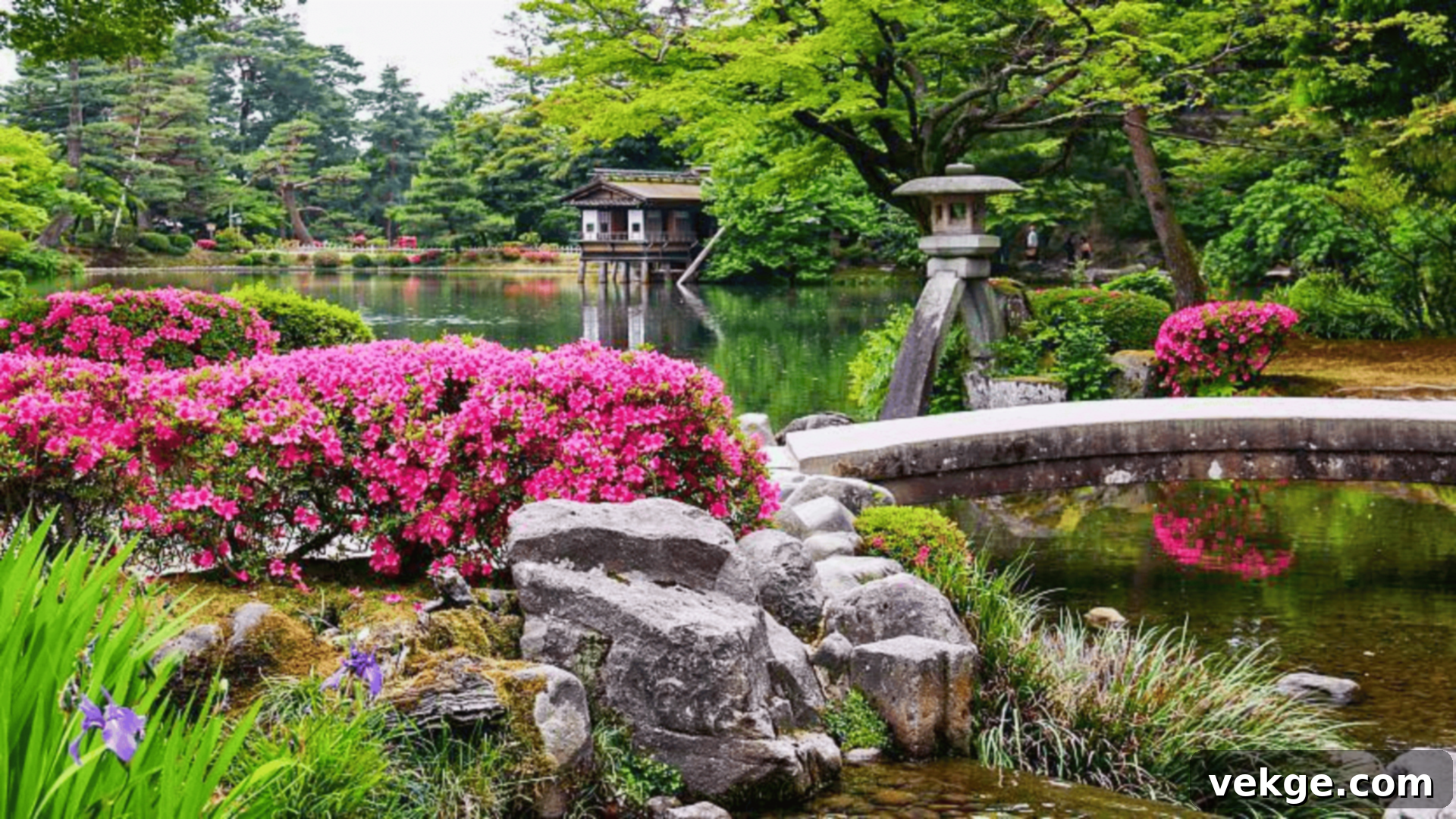
Kenrokuen Garden, situated in Kanazawa, is celebrated as one of Japan’s “Three Great Gardens” and perfectly exemplifies the enduring aesthetic of wabi-sabi and the principles of minimalist landscape design. Its expansive design features a masterful arrangement of ponds, streams, waterfalls, tea houses, and hills, all contributing to a landscape that feels both natural and artfully composed.
The garden’s beauty lies in its elegant simplicity and harmonious balance, showcasing natural elements like rocks, ancient trees, and water features in a minimalistic yet profoundly expressive arrangement. It is meticulously maintained to encourage visitors to experience nature in its purest, most refined form, inviting a sense of calm and deep appreciation for its subtle grandeur.
22. Tei-en Garden
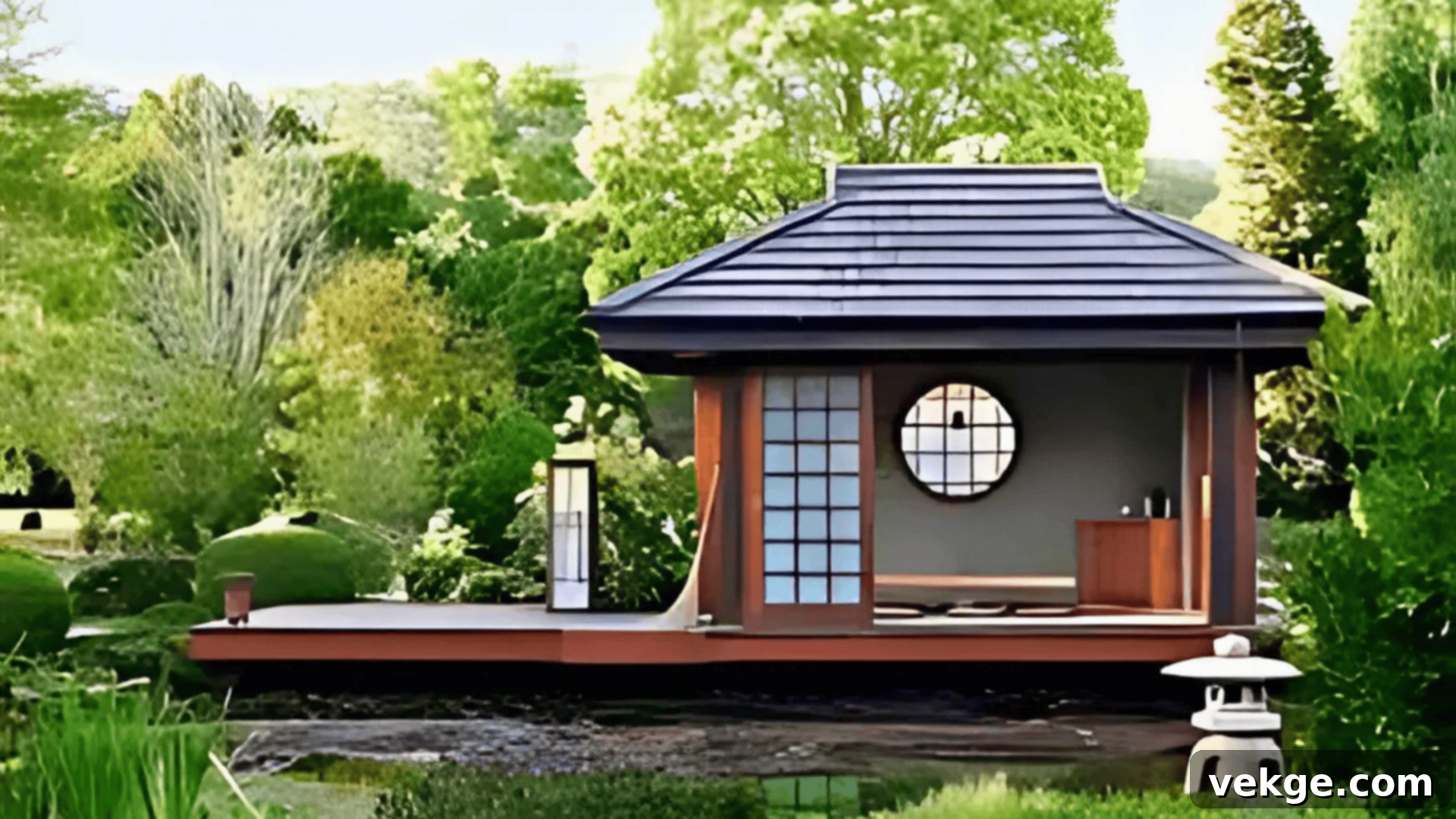
The Tei-en Garden in Kyoto is a smaller, exquisitely tranquil garden that epitomizes the minimalist aesthetic through its emphasis on clean lines and deliberate simplicity. Designed as a sanctuary for quiet reflection and meditation, it features minimal decoration, allowing the inherent beauty of natural elements like carefully chosen rocks, resilient trees, and serene water features to take center stage.
Every component in the Tei-en Garden is purposefully placed to create a harmonious composition, reflecting the minimalist design principles that define much of Japan’s architectural and landscape approach. It provides a peaceful retreat, inviting visitors to find beauty in austerity and a deep connection to nature’s fundamental forms.
Sustainable and Earthquake-Resistant Architecture
Given its unique geographical challenges and a forward-thinking environmental consciousness, Japan stands at the forefront of sustainable and earthquake-resistant architecture. Modern Japanese buildings seamlessly incorporate advanced green technologies and eco-friendly materials, meticulously designed to minimize environmental impact and maximize resource efficiency.
Designs frequently prioritize energy efficiency, strategically utilizing natural resources like sunlight for passive heating and daylighting, and wind for natural ventilation and cooling. This commitment to sustainability extends to the choice of construction materials, favoring those that are renewable, recycled, or have a low carbon footprint. Structures like the Suntory Museum of Art and The Green Building in Tokyo exemplify this dedication, focusing on reducing energy consumption and utilizing environmentally friendly materials to create a harmonious balance between human habitation and ecological responsibility.
23. Suntory Museum of Art
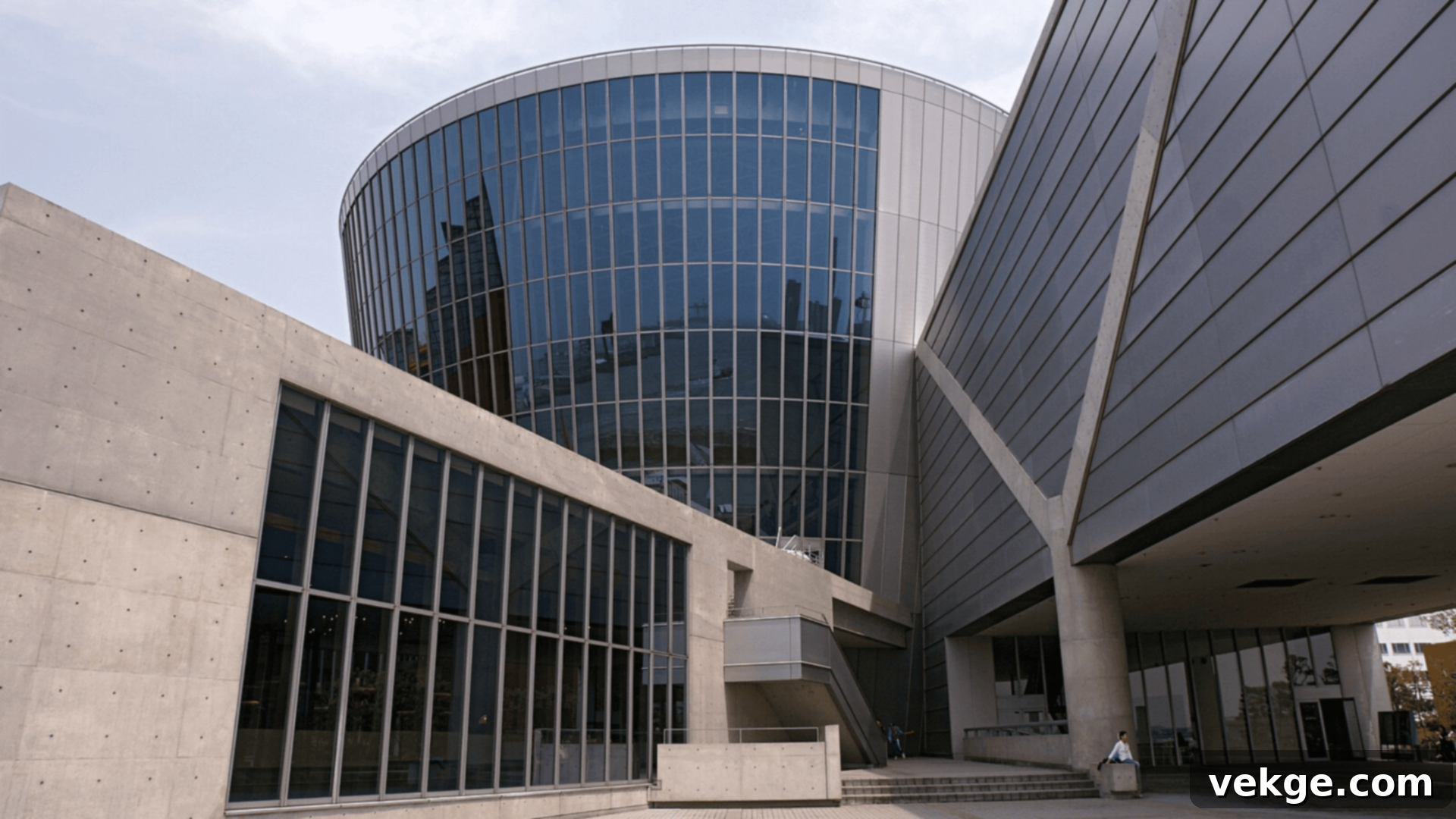
Opened in 2007, the Suntory Museum of Art in Tokyo is a prime example of eco-friendly architecture gracefully integrated into an urban setting. Its design thoughtfully incorporates principles of natural lighting and utilizes highly energy-efficient systems to minimize its environmental footprint. The building’s exterior, made from various wooden elements, blends seamlessly into the natural environment, creating a warm and inviting aesthetic.
This museum not only showcases art but also serves as a testament to Japan’s unwavering commitment to sustainability in contemporary architecture. It demonstrates how modern cultural institutions can be both architecturally striking and environmentally responsible, setting a high standard for green building practices in urban environments.
24. The Green Building
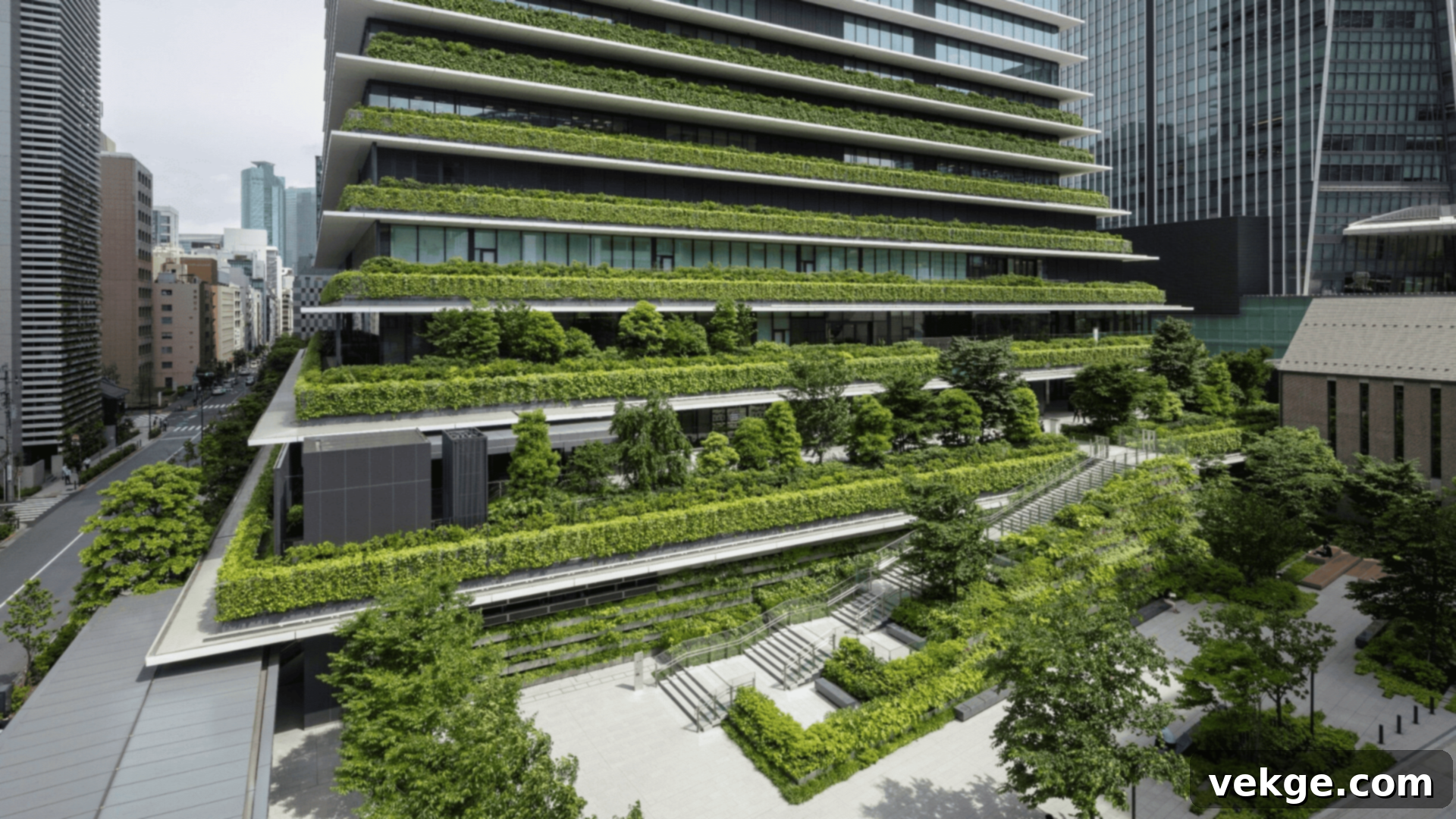
The Green Building in Tokyo is a stellar modern example of Japan’s dedication to sustainable design, making it a prominent feature in the city’s green initiatives. It incorporates state-of-the-art energy-efficient technologies, including extensive solar panels for renewable energy generation and strategically integrated green spaces, such as rooftop gardens and living walls, to improve air quality and reduce the urban heat island effect.
This building represents Japan’s growing focus on eco-conscious architecture, aiming to significantly reduce its carbon footprint while actively promoting environmental awareness and sustainable urban living. It stands as a beacon for future developments, demonstrating that cutting-edge design can go hand-in-hand with ecological responsibility.
Earthquake-Resistant Design
Given Japan’s precarious location on the Pacific Ring of Fire, a region prone to frequent and powerful seismic activity, earthquake-resistant architecture is not merely a preference but an absolute imperative. Japanese buildings are world-renowned for their incorporation of advanced seismic engineering techniques, meticulously designed to withstand even the strongest earthquakes, protecting both the structures themselves and their occupants.
Modern structures, ranging from towering skyscrapers like the Tokyo Skytree to critical government buildings like The Tokyo Metropolitan Government Building, integrate a sophisticated array of technologies. These include flexible structural frames that can sway with ground motion, advanced damping systems that absorb seismic energy, and base isolation systems that decouple the building from the ground, all working in concert to ensure stability and safety during seismic events.
25. The Tokyo Metropolitan Government Building

Completed in 1991, The Tokyo Metropolitan Government Building is not only an iconic landmark with its distinctive twin towers and neo-Gothic-inspired architecture but also a paragon of earthquake-resistant design. Its construction involved pioneering engineering techniques to ensure its resilience in one of the world’s most seismically active regions.
The building is equipped with advanced damping systems and a robust structural framework that allows it to absorb and dissipate the immense energy from earthquakes, maintaining its stability and integrity during seismic events. This state-of-the-art resilience makes it one of the most important and safest buildings in Tokyo, symbolizing the city’s commitment to safety and innovation.
Architectural Influence and Evolution
Japanese architecture has experienced a profound and dynamic transformation over the centuries, characterized by a continuous dialogue between its deeply ingrained traditional elements and the integration of cutting-edge modern designs. Traditional buildings, such as serene temples, spiritual shrines, and humble tea houses, emphasize simplicity, a deep connection to nature, and the skillful use of natural, locally sourced materials, particularly wood.
In stark contrast, modern Japanese buildings embrace materials like steel, glass, and concrete to forge sleek, highly functional designs that reflect the nation’s technological prowess. Despite this shift towards industrial materials and contemporary forms, the core principles of traditional aesthetics, such as the seamless integration of natural light, the creation of open and fluid spaces, and a minimalist approach, are often meticulously maintained and reinterpreted. The Tokyo International Forum and The National Diet Building are excellent exemplars of how these distinct architectural styles not only coexist but also enrich each other within contemporary Japan, showcasing a unique blend of heritage and progress.
26. The National Diet Building
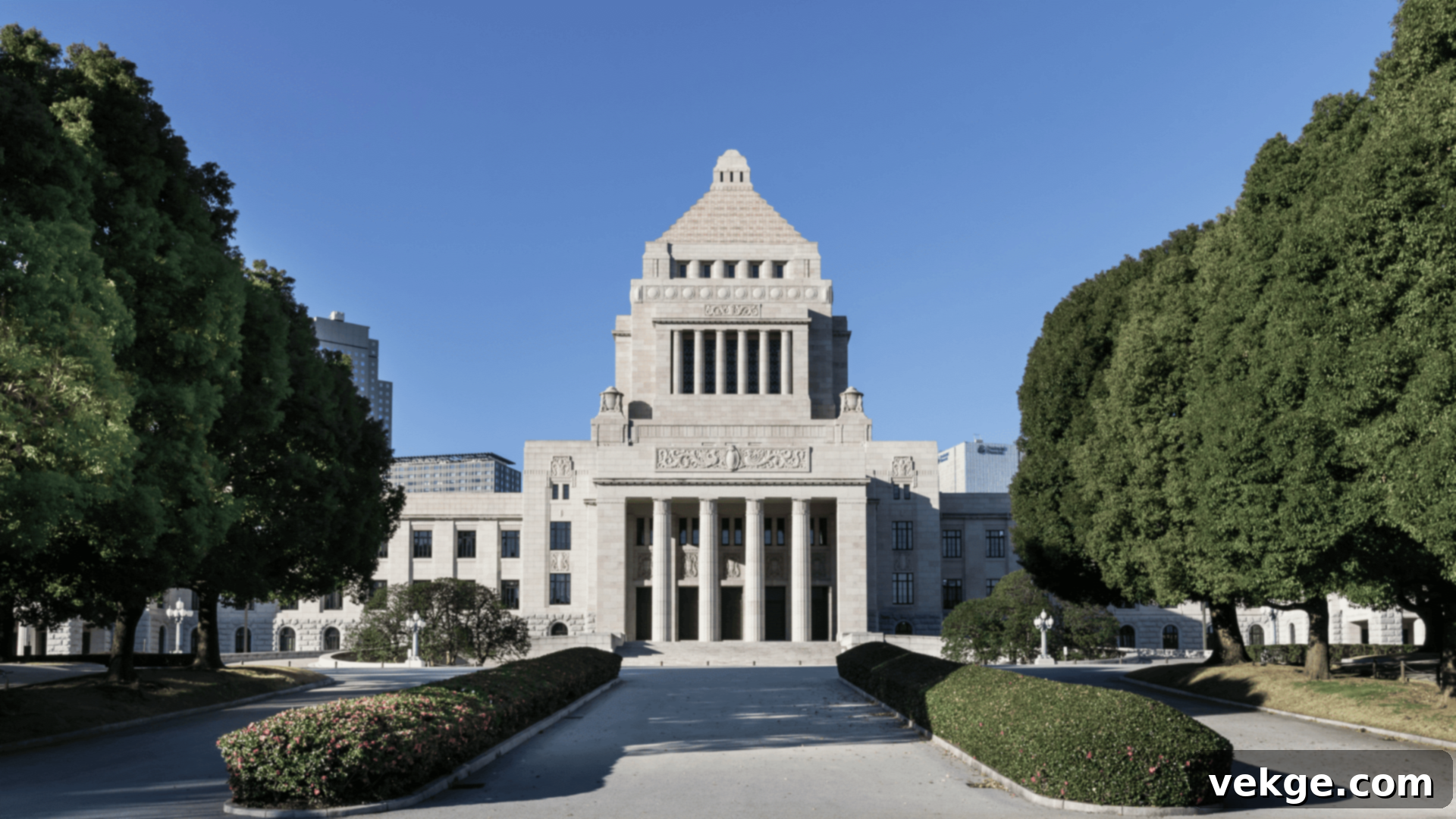
The National Diet Building, completed in 1936, stands as a fascinating architectural hybrid, consciously combining traditional Japanese stylistic elements with the grandeur of Western architectural styles. While its imposing Neo-Renaissance façade and classical symmetry clearly show Western influences, it distinctly reflects Japanese design through its traditional tiled roof and the prominent use of carefully selected domestic natural materials, such as granite from various prefectures.
This deliberate blending of cultural influences represents a crucial period in Japan’s history, symbolizing the fusion of its ancient heritage with its modern political aspirations and evolving architectural identity. It serves as a powerful visual metaphor for a nation navigating between its rich past and its future on the global stage.
Global Influence of Japanese Architecture
Japanese architecture, particularly its profound commitment to minimalist design, has exerted an enormous and far-reaching impact on global architectural trends. The core principles of simplicity, clean lines, meticulous craftsmanship, and a deep, respectful connection to nature have inspired and reshaped architectural thought and practice worldwide. Architects globally continue to draw inspiration from Japanese aesthetics, incorporating its lessons into diverse projects across different cultures.
Buildings like the Mori Art Museum and even the earlier-mentioned Tokyo International Forum are not just Japanese marvels but also highlight how the unique principles embedded in Japanese architecture have influenced and continue to shape contemporary designs around the world. This global fascination underscores the timeless appeal and universal relevance of Japan’s distinctive approach to space, form, and human experience.
27. Mori Art Museum
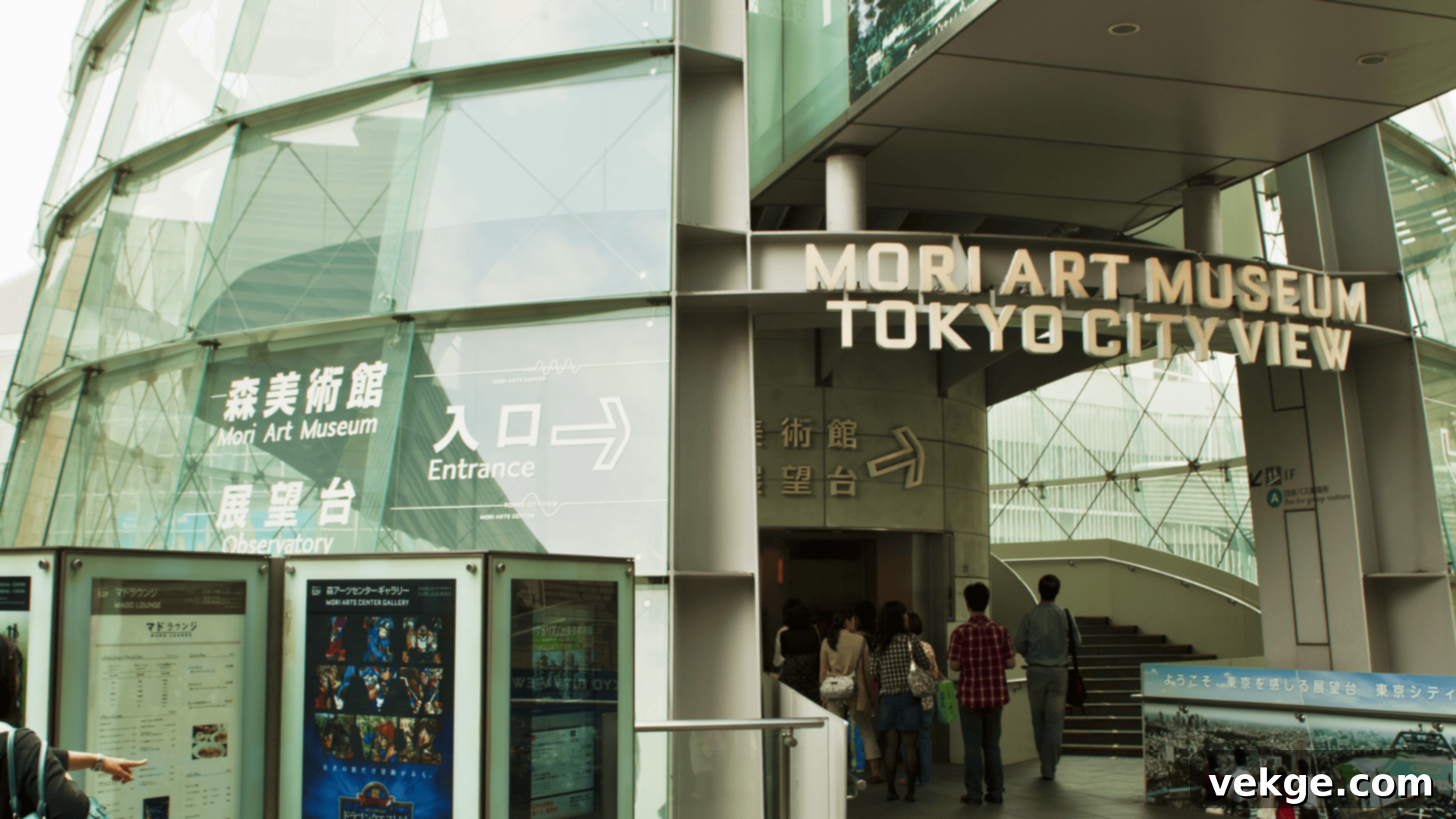
Located high within the Roppongi Hills Mori Tower, the Mori Art Museum is a prime example of how minimalist design can create powerful and sophisticated spaces. Its clean lines, expansive open spaces, and understated aesthetics profoundly reflect the influence of traditional Japanese architectural principles on modern building design. The museum’s interior spaces are designed to put the art first, with the architecture serving as a supportive, almost invisible framework.
The museum’s design showcases the global appeal and adaptability of Japan’s architectural approach to optimizing space, manipulating light, and ensuring high functionality. It demonstrates how a minimalist philosophy, rooted in deep cultural history, can translate into compelling contemporary structures that resonate with an international audience.
Conclusion
In this comprehensive exploration, we’ve journeyed through Japan’s architectural wonders, discovering how this fascinating nation masterfully blends the ancient with the avant-garde. We’ve seen how centuries-old temples and majestic castles stand in dynamic conversation with sleek, modern skyscrapers and innovative designs, creating a unique urban and cultural landscape.
We delved into the distinctive features that define Japanese architecture, such as the integral use of wood, the thoughtful incorporation of natural light, the profound connection to surrounding nature, and the timeless beauty of minimalist design. Furthermore, we highlighted Japan’s pioneering focus on engineering buildings to be exceptionally earthquake-resistant and increasingly eco-friendly, demonstrating a deep commitment to both safety and environmental stewardship.
Japanese architecture is in a perpetual state of evolution, yet it consistently maintains a strong, authentic connection to its rich historical and philosophical roots. This captivating fusion of simplicity, advanced technology, and profound cultural respect continues to inspire architects and designers across the globe, solidifying Japan’s position as a global leader in innovative and sustainable building practices.
Want to learn more about the captivating world of architecture and design? Check out other engaging blogs on our website!
